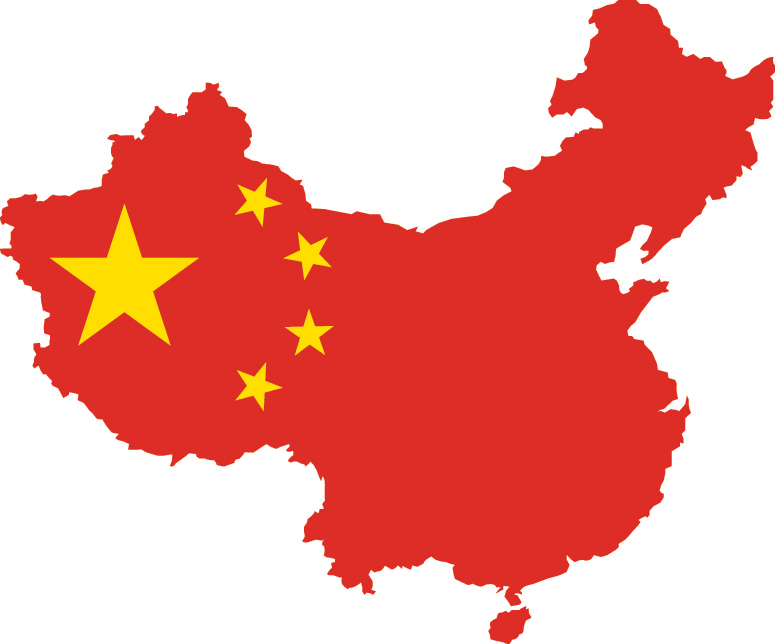 According to the IMF, Chinese GDP grew by 5.2% in 2023 and is predicted to grow by 4.6% this year. Such growth rates would be extremely welcome to most developed countries. UK growth in 2023 was a mere 0.5% and is forecast to be only 0.6% in 2024. Advanced economies as a whole only grew by 1.6% in 2023 and are forecast to grow by only 1.5% this year. Also, with the exception of India, the Philippines and Indonesia, which grew by 6.7%, 5.3% and 5.0% respectively in 2023 and are forecast to grow by 6.5%, 6.0% and 5.0% this year, Chinese growth also compares very favourably with other developing countries, which as a weighted average grew by 4.1% last year and are forecast to grow at the same rate this year.
According to the IMF, Chinese GDP grew by 5.2% in 2023 and is predicted to grow by 4.6% this year. Such growth rates would be extremely welcome to most developed countries. UK growth in 2023 was a mere 0.5% and is forecast to be only 0.6% in 2024. Advanced economies as a whole only grew by 1.6% in 2023 and are forecast to grow by only 1.5% this year. Also, with the exception of India, the Philippines and Indonesia, which grew by 6.7%, 5.3% and 5.0% respectively in 2023 and are forecast to grow by 6.5%, 6.0% and 5.0% this year, Chinese growth also compares very favourably with other developing countries, which as a weighted average grew by 4.1% last year and are forecast to grow at the same rate this year.
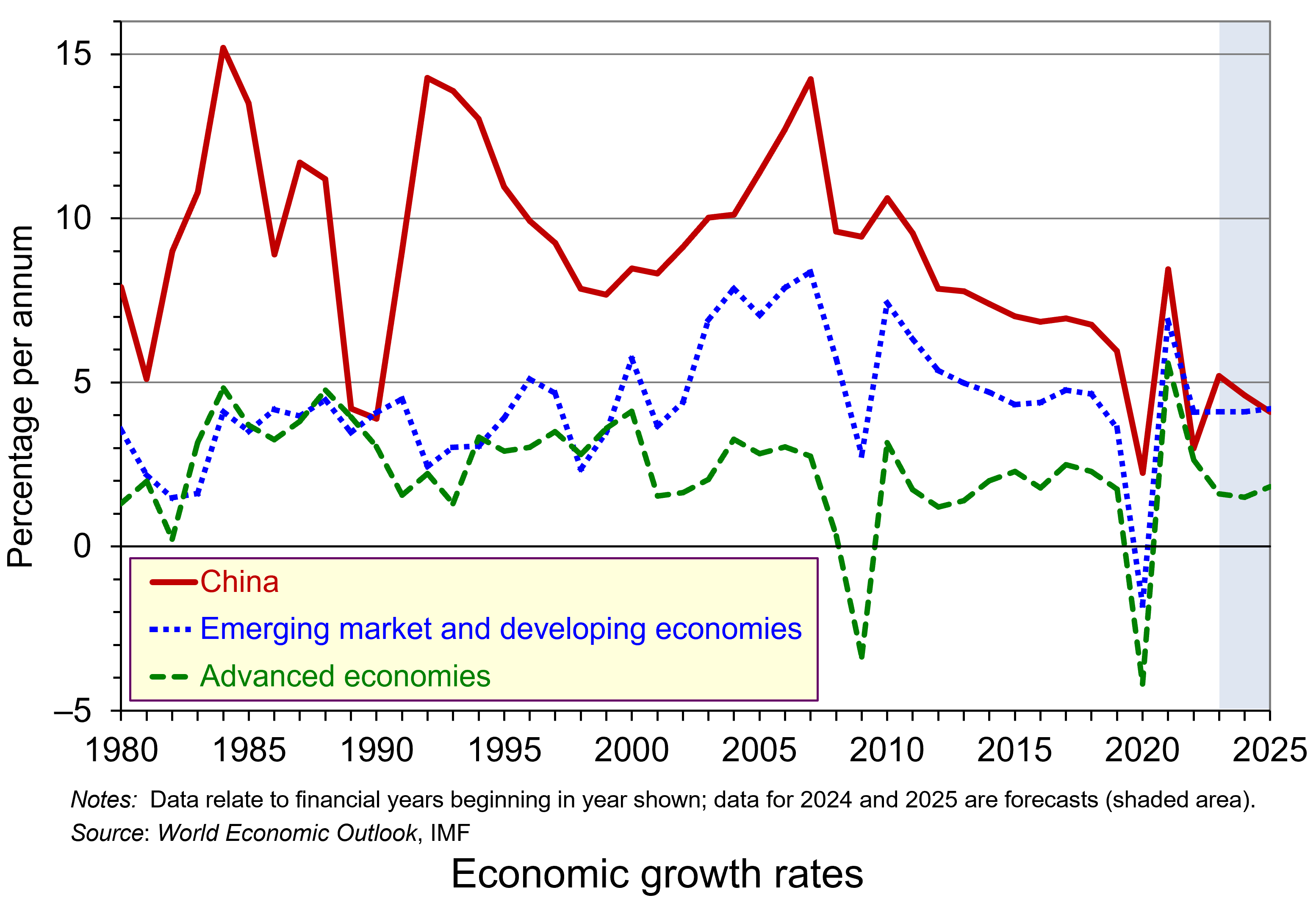 But in the past, Chinese growth was much higher and was a major driver of global growth. Over the period 1980 to 2018, Chinese economic growth averaged 9.5% – more than twice the average rate of developing countries (4.5%) and nearly four times the average rate of advanced countries (2.4%) (see chart – click here for a PowerPoint of the chart).
But in the past, Chinese growth was much higher and was a major driver of global growth. Over the period 1980 to 2018, Chinese economic growth averaged 9.5% – more than twice the average rate of developing countries (4.5%) and nearly four times the average rate of advanced countries (2.4%) (see chart – click here for a PowerPoint of the chart).
Not only is Chinese growth now much lower, but it is set to decline further. The IMF forecasts that in 2025, Chinese growth will have fallen to 4.1% – below the forecast developing-country average of 4.2% and well below that of India (6.5%).
Causes of slowing Chinese growth
There are a number of factors that have come together to contribute to falling economic growth rates – growth rates that otherwise would have been expected to be considerably higher as the Chinese economy reopened after severe Covid lockdowns.
 Property market
Property market
China has experienced a property boom over the past 20 years years as the government has encouraged construction in residential blocks and in factories and offices. The sector has accounted for some 20% of economic activity. But for many years, demand outstripped supply as consumers chose to invest in property, partly because of a lack of attractive alternatives for their considerable savings and partly because property prices were expected to go on rising. This lead to speculation on the part of both buyers and property developers. Consumers rushed to buy property before prices rose further and property developers borrowed considerably to buy land, which local authorities encouraged, as it provided a valuable source of revenue.
But now there is considerable overcapacity in the sector and new building has declined over the past three years. According to the IMF:
Housing starts have fallen by more than 60 per cent relative to pre-pandemic levels, a historically rapid pace only seen in the largest housing busts in cross-country experience in the last three decades. Sales have fallen amid homebuyer concerns that developers lack sufficient financing to complete projects and that prices will decline in the future.
As a result, many property developers have become unviable. At the end of January, the Chinese property giant, Evergrande, was ordered to liquidate by a Hong Kong court, after the judge ruled that the company did not have a workable plan to restructure around $300bn of debt. Over 50 Chinese property developers have defaulted or missed payments since 2020. The liquidation of Evergrande and worries about the viability of other Chinese property developers is likely to send shockwaves around the Chinese property market and more widely around Chinese investment markets.
Overcapacity
Rapid investment over many years has led to a large rise in industrial capacity. This has outstripped demand. The problem could get worse as investment, including state investment, is diverted from the property sector to manufacturing, especially electric vehicles. But with domestic demand dampened, this could lead to increased dumping on international markets – something that could spark trade wars with the USA and other trading partners (see below). Worries about this in China are increasing as the possibility of a second Trump presidency looks more possible. The Chinese authorities are keen to expand aggregate demand to tackle this overcapacity.
Uncertainty
Consumer and investor confidence are low. This is leading to severe deflationary pressures. If consumers face a decline in the value of their property, this wealth effect could further constrain their spending. This will, in turn, dampen industrial investment.
Uncertainty is beginning to affect foreign companies based in China. Many foreign companies are now making a loss in China or are at best breaking even. This could lead to disinvestment and add to deflationary pressures.
The Chinese stock market and policy responses
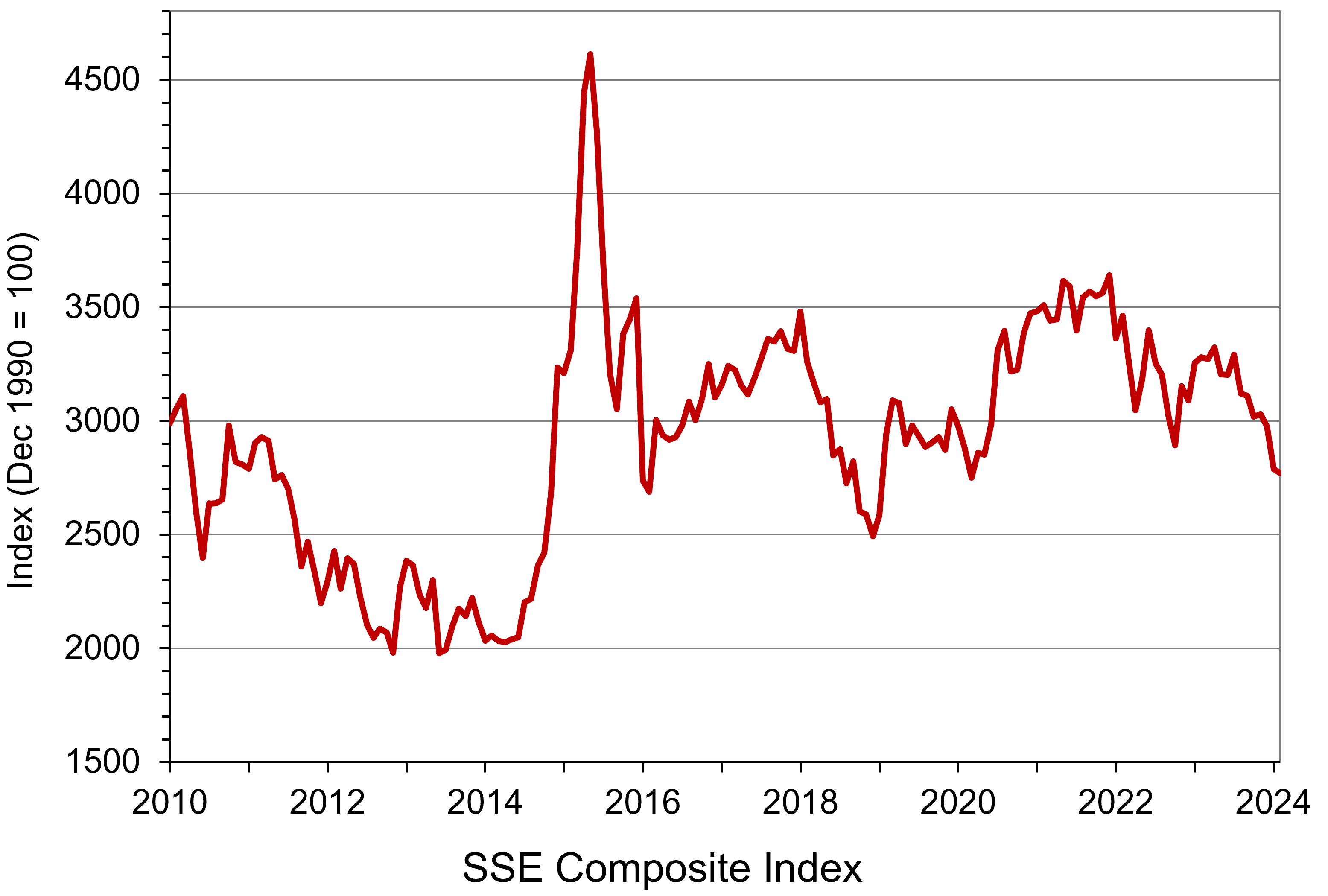 Lack of confidence in the Chinese economy is reflected in falling share prices. The Shanghai SSE Composite Index (an index of all stocks traded on the Shanghai Stock Exchange) has fallen dramatically in recent months. From a high of 3703 in September 2021, it had fallen to 2702 on 5 Feb 2024 – a fall of 27%. It is now below the level at the beginning of 2010 (see chart: click here for a PowerPoint). On 5 February alone, some 1800 stocks fell by over 10% in Shanghai and Shenzhen. People were sensing a rout and investors expressed their frustration and anger on social media, including the social media account of the US Embassy. The next day, the authorities intervened and bought large quantities of key stocks. China’s sovereign wealth fund announced that it would increase its purchase of shares to support the country’s stock markets. The SSE Composite rose 4.1% on 6 February and the Shenzhen Component Index rose 6.2%.
Lack of confidence in the Chinese economy is reflected in falling share prices. The Shanghai SSE Composite Index (an index of all stocks traded on the Shanghai Stock Exchange) has fallen dramatically in recent months. From a high of 3703 in September 2021, it had fallen to 2702 on 5 Feb 2024 – a fall of 27%. It is now below the level at the beginning of 2010 (see chart: click here for a PowerPoint). On 5 February alone, some 1800 stocks fell by over 10% in Shanghai and Shenzhen. People were sensing a rout and investors expressed their frustration and anger on social media, including the social media account of the US Embassy. The next day, the authorities intervened and bought large quantities of key stocks. China’s sovereign wealth fund announced that it would increase its purchase of shares to support the country’s stock markets. The SSE Composite rose 4.1% on 6 February and the Shenzhen Component Index rose 6.2%.
However, the rally eased as investors waited to see what more fundamental measures the authorities would take to support the stock markets and the economy more generally. Policies are needed to boost the wider economy and encourage a growth in consumer and business confidence.
Interest rates have been cut four times since the beginning of 2022, when the prime loan rate was cut from 3.85% to 3.7%. The last cut was from 3.55% to 3.45% in August 2023. But this has been insufficient to provide the necessary boost to aggregate demand. Further cuts in interest rates are possible and the government has said that it will use proactive fiscal and effective monetary policy in response to the languishing economy. However, government debt is already high, which limits the room for expansionary fiscal policy, and consumers are highly risk averse and have a high propensity to save.
Graduate unemployment
 China has seen investment in education as an important means of increasing human capital and growth. But with a slowing economy, there are are more young people graduating each year than there are graduate jobs available. Official data show that for the group aged 16–24, the unemployment rate was 14.9% in December. This compares with an overall urban unemployment rate of 5.1%. Many graduates are forced to take non-graduate jobs and graduate jobs are being offered at reduced salaries. This will have a further dampening effect on aggregate demand.
China has seen investment in education as an important means of increasing human capital and growth. But with a slowing economy, there are are more young people graduating each year than there are graduate jobs available. Official data show that for the group aged 16–24, the unemployment rate was 14.9% in December. This compares with an overall urban unemployment rate of 5.1%. Many graduates are forced to take non-graduate jobs and graduate jobs are being offered at reduced salaries. This will have a further dampening effect on aggregate demand.
Demographics
China’s one-child policy, which it pursued from 1980 to 2016, plus improved health and social care leading to greater longevity, has led to an ageing population and a shrinking workforce. This is despite recent increases in unemployment in the 16–24 age group. The greater the ratio of dependants to workers, the greater the brake on growth as taxes and savings are increasingly used to provide various forms of support.
Effects on the rest of the world
China has been a major driver of world economic growth. With a slowing Chinese economy, this will provide less stimulus to growth in other countries. Many multinational companies, including chip makers, cosmetics companies and chemical companies, earn considerable revenue from China. For example, the USA exports over $190 billion of goods and services to China and these support over 1 million jobs in the USA. A slowdown in China will have repercussions for many companies around the world.
There is also the concern that Chinese manufacturers may dump products on world markets at less than average (total) cost to shift stock and keep production up. This could undermine industry in many countries and could initiate a protectionist response. Already Donald Trump is talking about imposing a 10% tariff on most imported goods if he is elected again in November. Such tariffs could be considerably higher on imports from China. If Joe Biden is re-elected, he too may impose tariffs on Chinese goods if they are thought to be unfairly subsidised. US (and possibly EU) tariffs on Chinese goods could lead to a similar response from China, resulting in a trade war – a negative sum game.
Videos
Articles
- IMF Predicts China Economy Slowing Over Next Four Years
Voice of America, Evie Steele (2/2/24)
- China’s Real Estate Sector: Managing the Medium-Term Slowdown
IMF News, Henry Hoyle and Sonali Jain-Chandra (2/2/24)
- China braced for largest human migration on earth amid bleak economic backdrop
ITV News, Debi Edward (4/2/24)
- China’s property giant Evergrande ordered to liquidate as debt talks fail
Aljazeera (29/1/24)
- China’s overcapacity a challenge that is ‘here to stay’, says US chamber
Financial Times, Joe Leahy (1/2/24)
- China needs to learn lessons from 1990s Japan
Financial Times, Gillian Tett (1/2/24)
- The Trump factor is looming over China’s markets
Financial Times, Katie Martin (2/2/24)
- China’s many systemic problems dominate its outlook for 2024
The Guardian, George Magnus (1/1/24)
- China youth unemployment will stay elevated in 2024, but EIU warns economic impact will linger
CNBC, Clement Tan (25/1/24)
- Don’t count on a soft landing for the world economy – turbulence is ahead
The Guardian, Kenneth Rogoff (2/2/24)
- As falling stocks draw criticism in China, censors struggle to keep up
Washington Post, Lily Kuo (6/2/24)
- China’s doom loop: a dramatically smaller (and older) population could create a devastating global slowdown
The Conversation, Jose Caballero (12/2/24)
- China: why the country’s economy has hit a wall – and what it plans to do about it
The Conversation, Hong Bo (19/3/24)
- Confronting inflation and low growth
OECD Economic Outlook Interim Report (September 2023) (see especially Box 1)
Questions
- Why is China experiencing slowing growth and is growth likely to pick up over the next five years?
- How does the situation in China today compare with that in Japan 30 years ago?
- What policies could the Chinese government pursue to stimulate economic growth?
- What policies were enacted towards China during the Trump presidency from 2017 to 2020?
- Would you advise the Chinese central bank to cut interest rates further? Explain.
- Should China introduce generous child support for families, no matter the number of children?
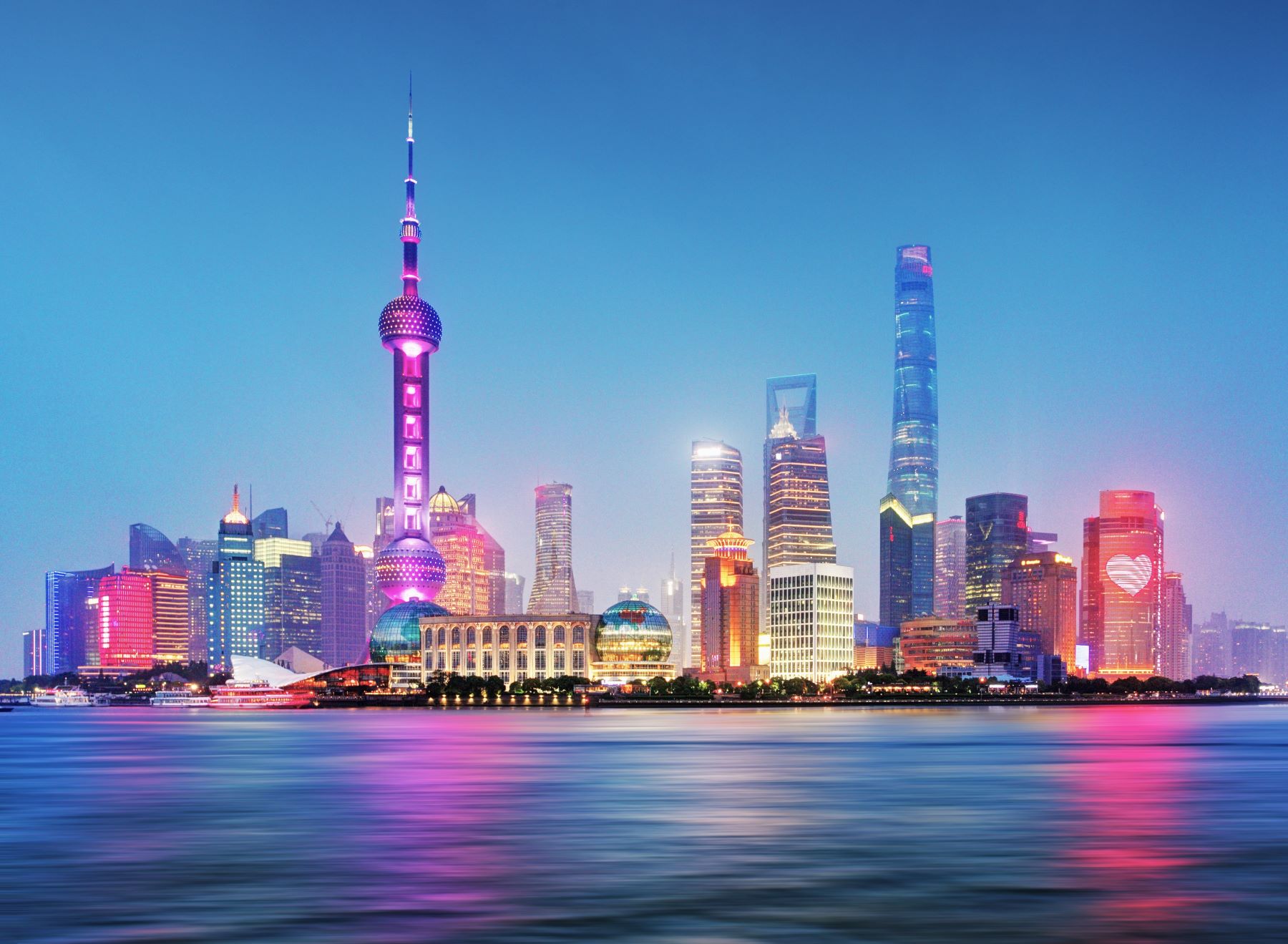 China has been an economic powerhouse in recent decades – a powerhouse that has helped to drive the world economy through trade and both inward and outward investment. At the same time, its low-priced exports have helped to dampen world inflation. But is all this changing? Is China, to use President Biden’s words, a ‘ticking time bomb’?
China has been an economic powerhouse in recent decades – a powerhouse that has helped to drive the world economy through trade and both inward and outward investment. At the same time, its low-priced exports have helped to dampen world inflation. But is all this changing? Is China, to use President Biden’s words, a ‘ticking time bomb’?
China’s economic growth rate is slowing, with the quarterly growth in GDP falling from 2.2% in Q1 this year to 0.8% in Q2. Even though public-sector investment rose by 8.1% in the first six months of this year, private-sector investment fell by 0.2%, reflecting waning business confidence. And manufacturing output declined in August. But, despite slowing growth, the Chinese government is unlikely to use expansionary fiscal policy because of worries about growing public-sector debt.
The property market
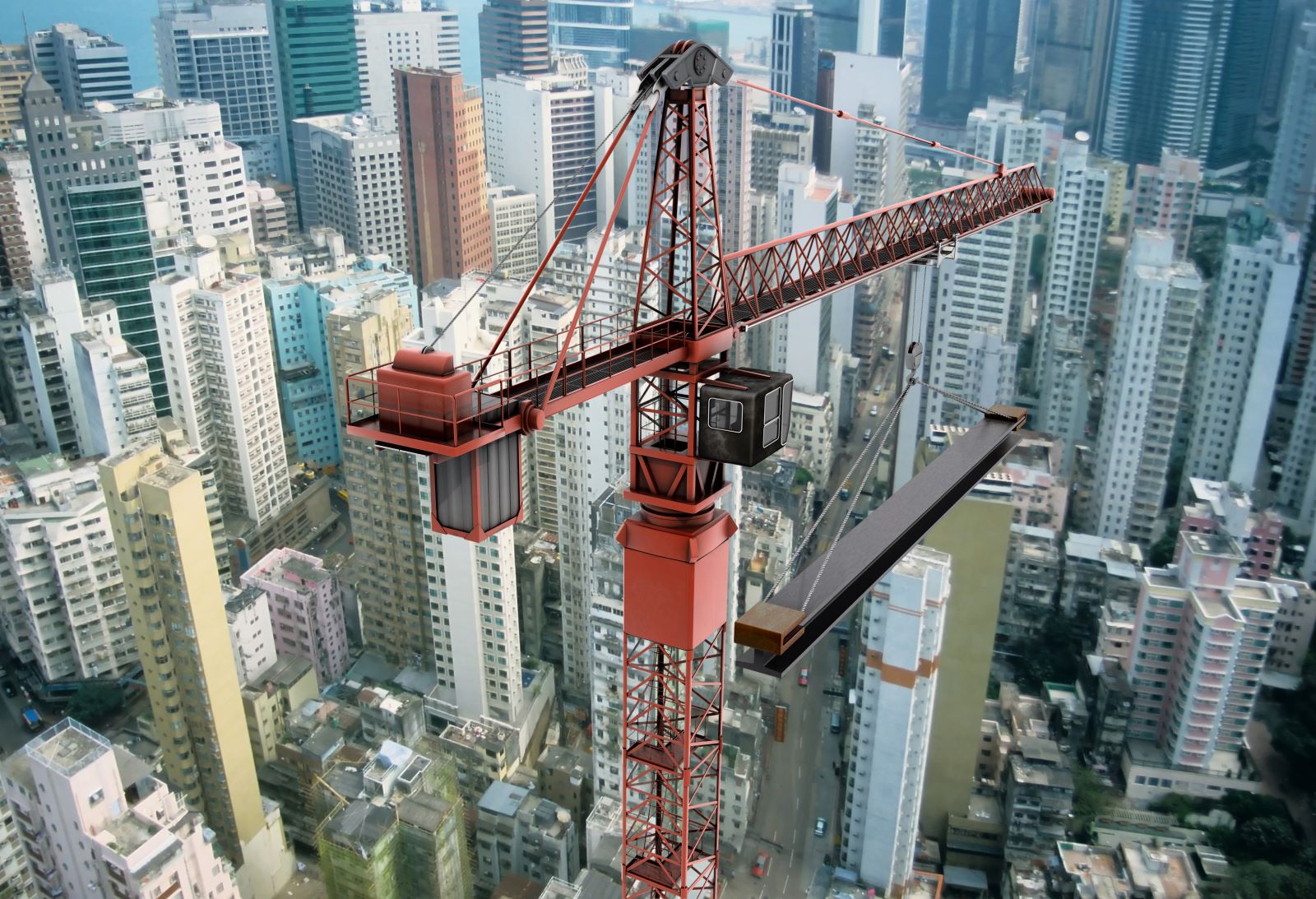 One of the biggest worries for the Chinese economy is the property market. The annual rate of property investment fell by 20.6% in June this year and new home prices fell by 0.2% in July (compared with June). The annual rate of price increase for new homes was negative throughout 2022, being as low as minus 1.6% in November 2022; it was minus 0.1% in the year to July 2023, putting new-home prices at 2.4% below their August 2021 level. However, these are official statistics. According to the Japan Times article linked below, which reports Bloomberg evidence, property agents and private data providers report much bigger falls, with existing home prices falling by at least 15% in many cities.
One of the biggest worries for the Chinese economy is the property market. The annual rate of property investment fell by 20.6% in June this year and new home prices fell by 0.2% in July (compared with June). The annual rate of price increase for new homes was negative throughout 2022, being as low as minus 1.6% in November 2022; it was minus 0.1% in the year to July 2023, putting new-home prices at 2.4% below their August 2021 level. However, these are official statistics. According to the Japan Times article linked below, which reports Bloomberg evidence, property agents and private data providers report much bigger falls, with existing home prices falling by at least 15% in many cities.
Falling home prices have made home-owners poorer and this wealth effect acts as a brake on spending. The result is that, unlike in many Western countries, there has been no post-pandemic bounce back in spending. There has also been a dampening effect on local authority spending. During the property boom they financed a proportion of their spending by selling land to property developers. That source of revenue has now largely dried up. And as public-sector revenues have been constrained, so this has constrained infrastructure spending – a major source of growth in China.
The government, however, has been unwilling to compensate for this by encouraging private investment and has tightened regulation of the financial sector. The result has been a decline in new jobs and a rise in unemployment, especially among graduates, where new white collar jobs in urban areas are declining. According to the BBC News article linked below, “In July, figures showed a record 21.3% of jobseekers between the ages of 16 and 25 were out of work”.
Deflation
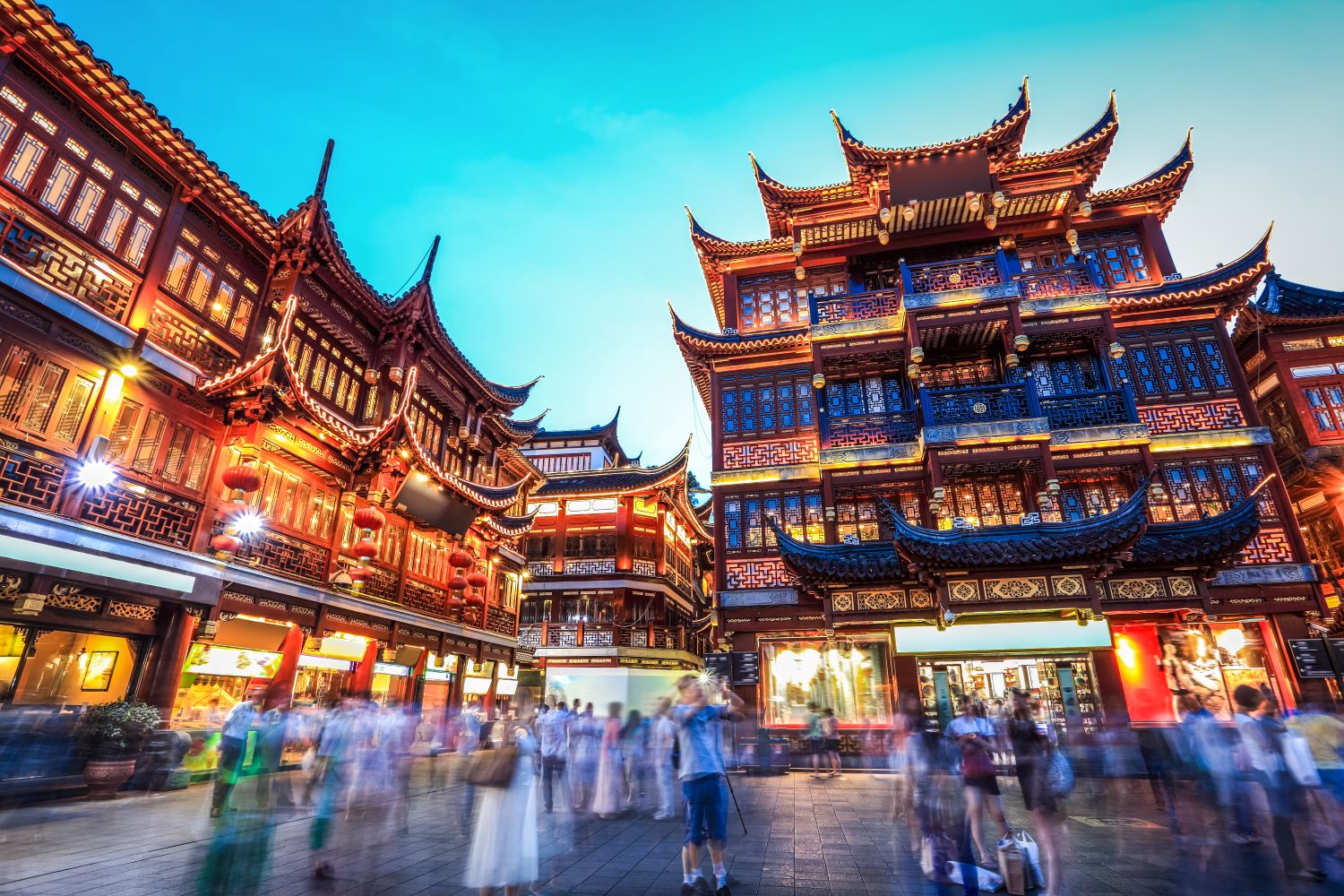 The fall in demand has caused consumer prices to fall. In the year to July 2023, they fell by 0.3%. Even though core inflation is still positive (0.8%), the likelihood of price reductions in the near future discourages spending as people hold back, waiting for prices to fall further. This further dampens the economy. This is a problem that was experienced in Japan over many years.
The fall in demand has caused consumer prices to fall. In the year to July 2023, they fell by 0.3%. Even though core inflation is still positive (0.8%), the likelihood of price reductions in the near future discourages spending as people hold back, waiting for prices to fall further. This further dampens the economy. This is a problem that was experienced in Japan over many years.
Despite slowing economic growth, Chinese annual growth in GDP for 2023 is still expected to be around 4.5% – much lower than the average rate for 9.5% from 1991 to 2019, but considerably higher than the average of 1.1% forecast for 2023 for the G7 countries. Nevertheless, China’s exports fell by 14.5% in the year to July 2023 and imports fell by 12.5%. The fall in imports represents a fall in exports to China from the rest of the world and hence a fall in injections to the rest-of-the-world economy. Currently China’s role as a powerhouse of the world has gone into reverse.
Articles
Questions
- Using PowerPoint or Excel, plot the growth rate of Chinese real GDP, real exports and real imports from 1990 to 2024 (using forecasts for 2023 and 2024). Use data from the IMF’s World Economic Outlook database. Comment on the figures.
- Explain the wealth effect from falling home prices.
- Why may official figures understate the magnitude of home price deflation?
- Explain the foreign trade multiplier and its relevance to other countries when the volume of Chinese imports changes. What determines the size of this multiplier for a specific country?
- How does the nature of the political system in China affect the likely policy response to the problems identified in this blog?
- Is there any good news for the rest of the world from the slowdown in the Chinese economy?
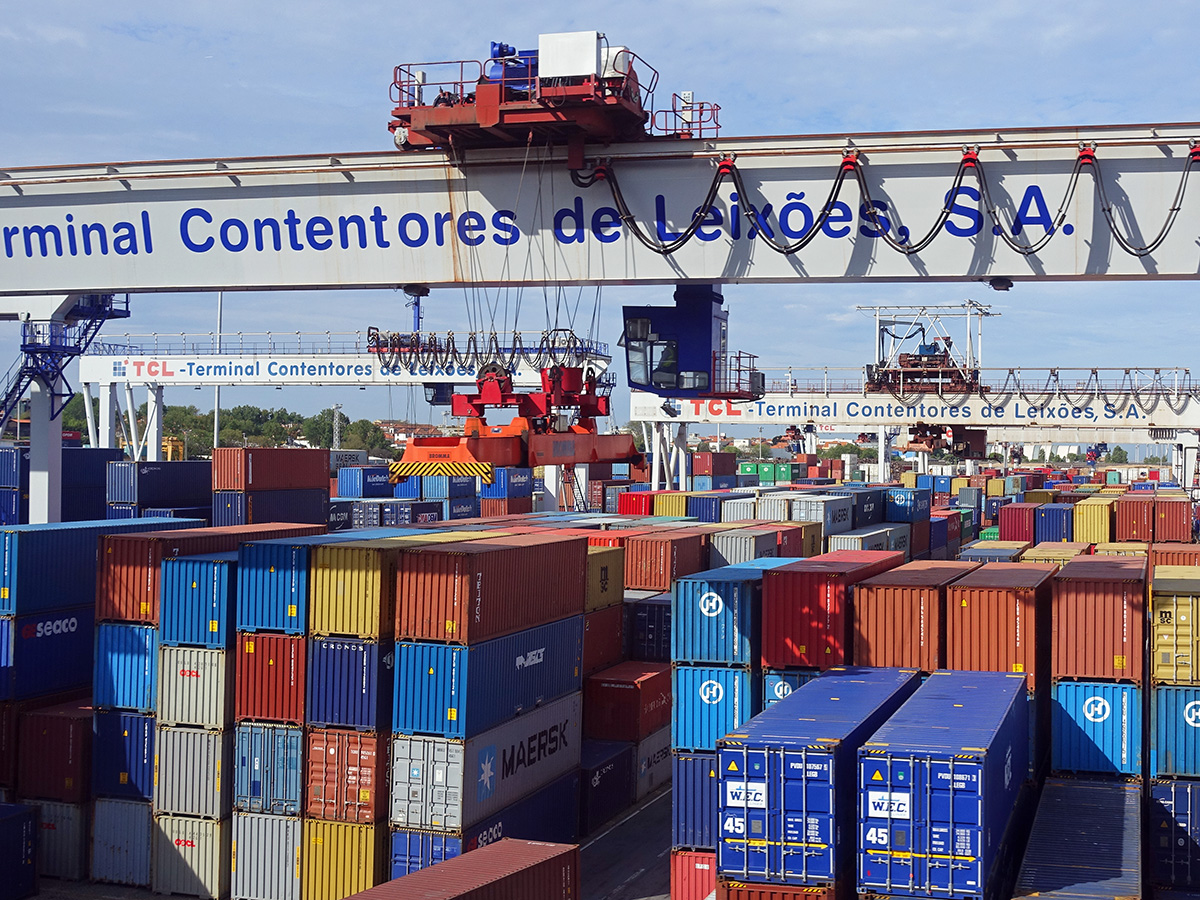 Over the decades, economies have become increasingly interdependent. This process of globalisation has involved a growth in international trade, the spread of technology, integrated financial markets and international migration.
Over the decades, economies have become increasingly interdependent. This process of globalisation has involved a growth in international trade, the spread of technology, integrated financial markets and international migration.
When the global economy is growing, globalisation spreads the benefits around the world. However, when there are economic problems in one part of the world, this can spread like a contagion to other parts. This was clearly illustrated by the credit crunch of 2007–8. A crisis that started in the sub-prime market in the USA soon snowballed into a worldwide recession. More recently, the impact of Covid-19 on international supply chains has highlighted the dangers of relying on a highly globalised system of production and distribution. And more recently still, the war in Ukraine has shown the dangers of food and fuel dependency, with rapid rises in prices of basic essentials having a disproportionate effect on low-income countries and people on low incomes in richer countries.
Moves towards autarky
So is the answer for countries to become more self-sufficient – to adopt a policy of greater autarky? Several countries have moved in this direction. The USA under President Trump pursued a much more protectionist agenda than his predecessors. The UK, although seeking new post-Brexit trade relationships, has seen a reduction in trade as new barriers with the EU have reduced UK exports and imports as a percentage of GDP. 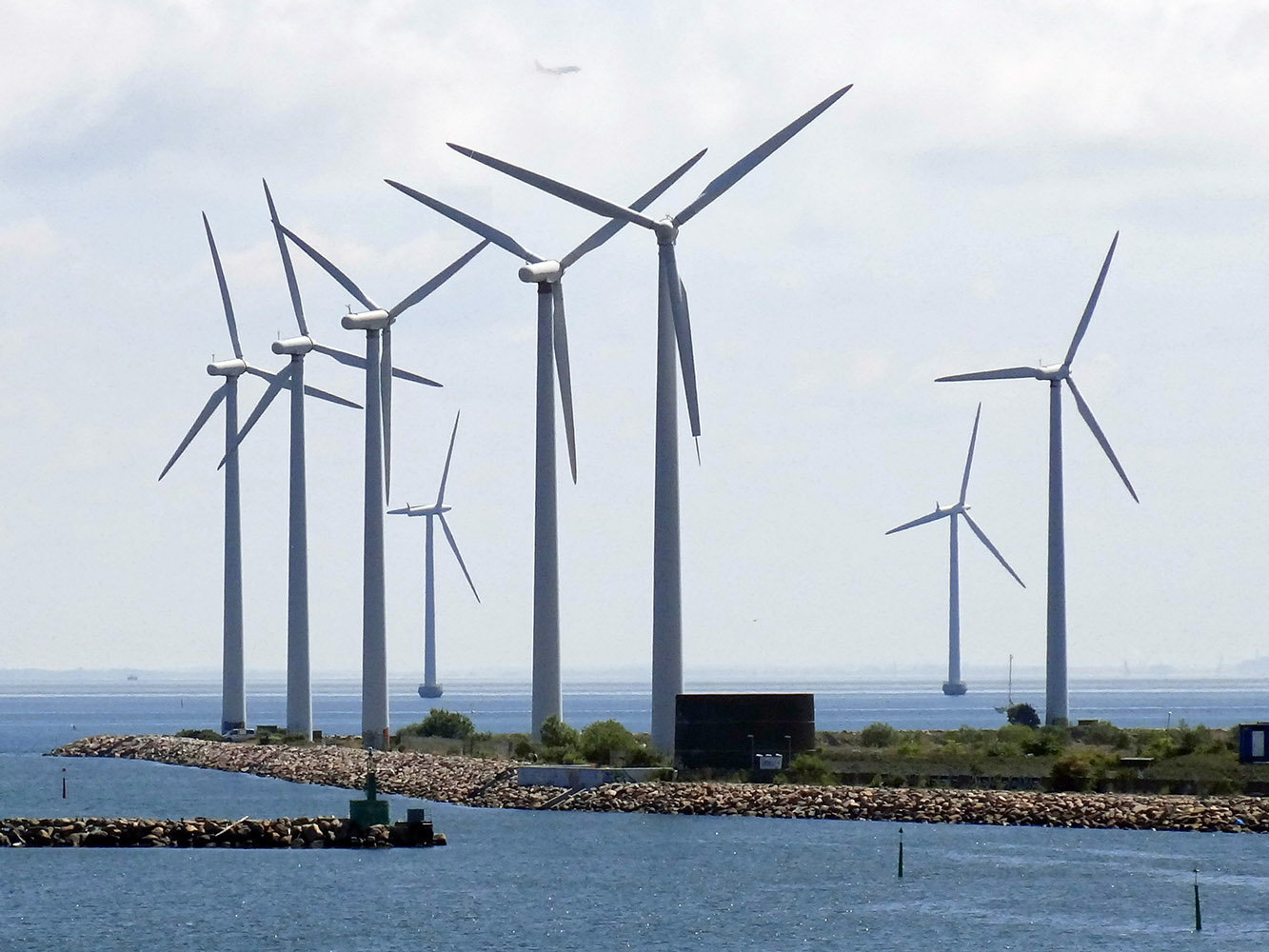 According to the Office for Budget Responsibility’s November 2022 Economic and Fiscal Outlook, Brexit will result in the UK’s trade intensity being 15 per cent lower in the long run than if it had remained in the EU.
According to the Office for Budget Responsibility’s November 2022 Economic and Fiscal Outlook, Brexit will result in the UK’s trade intensity being 15 per cent lower in the long run than if it had remained in the EU.
Many European countries are seeking to achieve greater energy self-sufficiency, both as a means of reducing reliance on Russian oil and gas, but also in pursuit of a green agenda, where a greater proportion of energy is generated from renewables. More generally, countries and companies are considering how to reduce the risks of relying on complex international supply chains.
Limits to the gains from trade
The gains from international trade stem partly from the law of comparative advantage, which states that greater levels of production can be achieved by countries specialising in and exporting those goods that can be produced at a lower opportunity cost and importing those in which they have a comparative disadvantage. Trade can also lead to the transfer of technology and a downward pressure on costs and prices through greater competition.
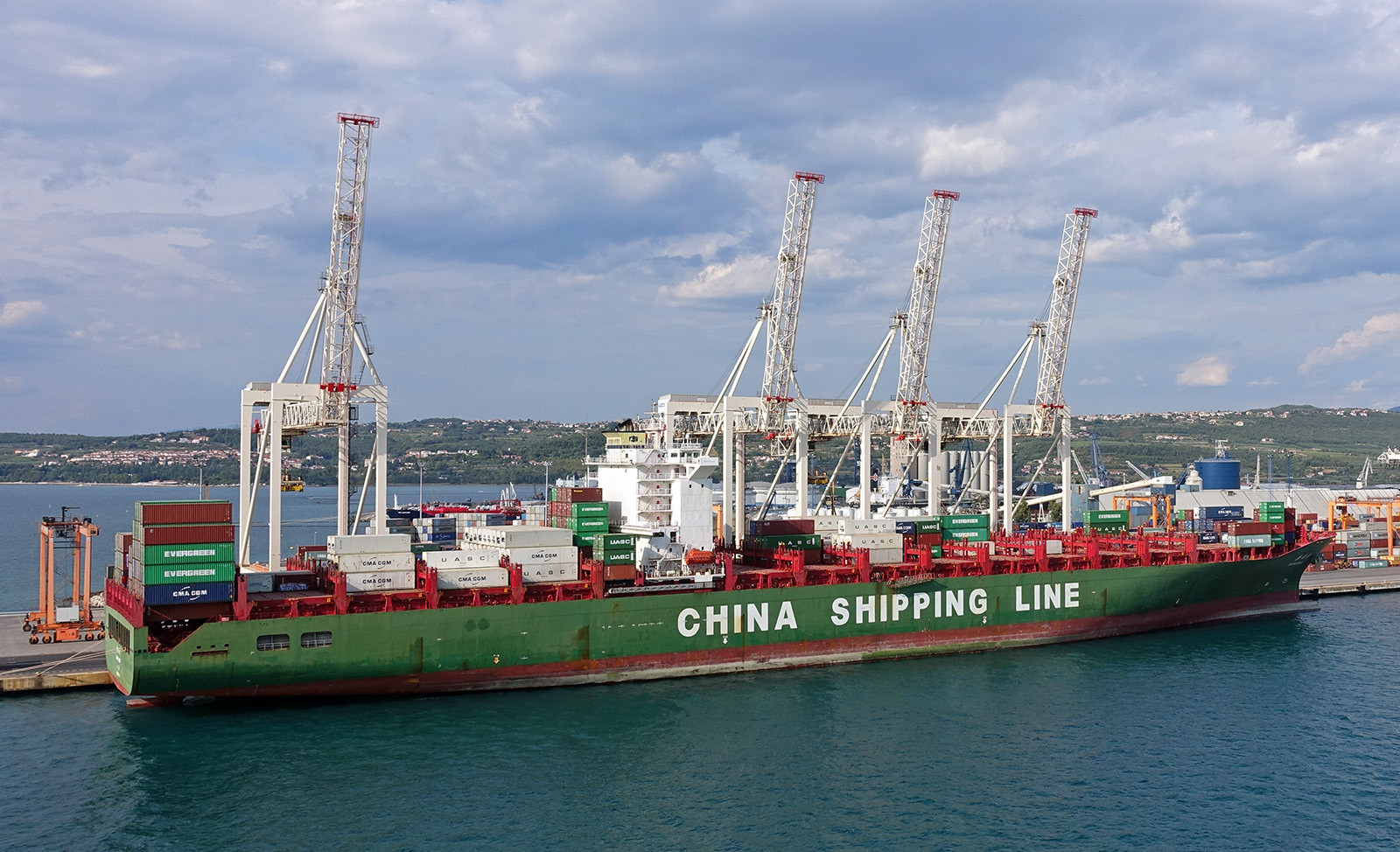 But trade can increase dependence on unreliable supply sources. For example, at present, some companies are seeking to reduce their reliance on Taiwanese parts, given worries about possible Chinese actions against Taiwan.
But trade can increase dependence on unreliable supply sources. For example, at present, some companies are seeking to reduce their reliance on Taiwanese parts, given worries about possible Chinese actions against Taiwan.
Also, governments have been increasingly willing to support domestic industries with various non-tariff barriers to imports, especially since the 2007–8 financial crisis. Such measures include subsidies, favouring domestic firms in awarding government contracts and using regulations to restrict imports. These protectionist measures are often justified in terms of achieving security of supply. The arguments apply particularly starkly in the case of food. In the light of large price increases in the wake of the Ukraine war, many countries are considering how to increase food self-sufficiency, despite it being more costly.
Also, trade in goods involves negative environmental externalities, as freight transport, whether by sea, air or land, involves emissions and can add to global warming. In 2021, shipping emitted over 830m tonnes of CO2, which represents some 3% of world total CO2 emissions. In 2019 (pre-pandemic), the figure was 800m tonnes. The closer geographically the trading partner, the lower these environmental costs are likely to be.
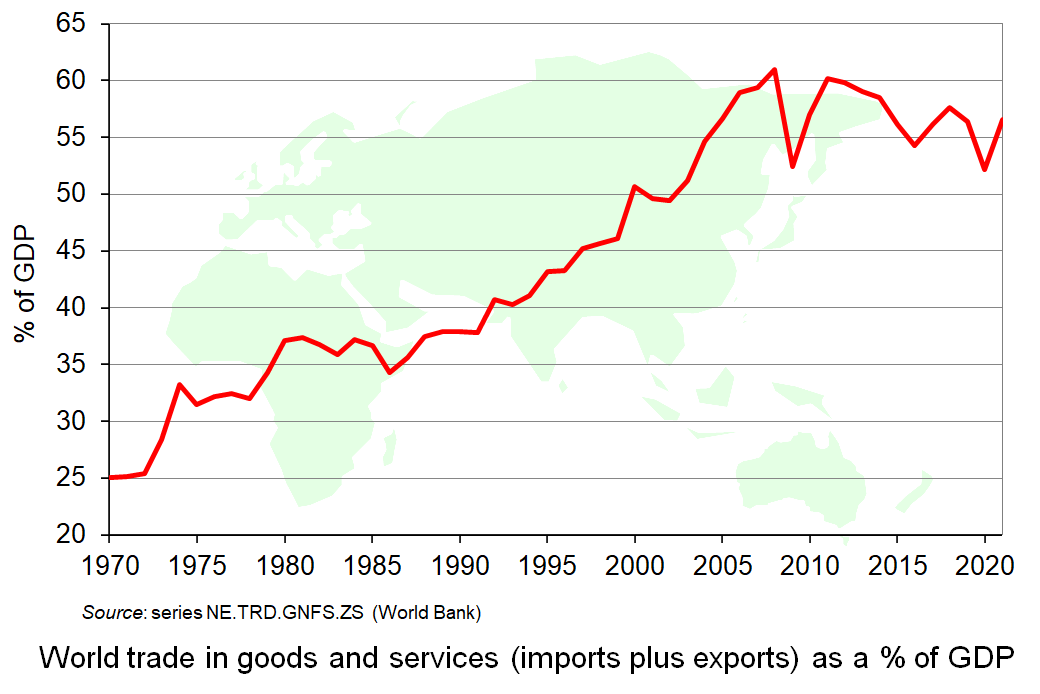 The problems with a globally interdependent world have led to world trade growing more slowly than world GDP in recent years after decades of trade growth considerably outstripping GDP growth. Trade (imports plus exports) as a percentage of GDP peaked at just over 60% in 2008. In 2019 and 2021 it was just over 56%. This is illustrated in the chart (click here for a PowerPoint). Although trade as a percentage of GDP rose slightly from 2020 to 2021 as economies recovered from the pandemic, it is expected to have fallen back again in 2022 and possibly further in 2023.
The problems with a globally interdependent world have led to world trade growing more slowly than world GDP in recent years after decades of trade growth considerably outstripping GDP growth. Trade (imports plus exports) as a percentage of GDP peaked at just over 60% in 2008. In 2019 and 2021 it was just over 56%. This is illustrated in the chart (click here for a PowerPoint). Although trade as a percentage of GDP rose slightly from 2020 to 2021 as economies recovered from the pandemic, it is expected to have fallen back again in 2022 and possibly further in 2023.
But despite this reduction in trade as a percentage of GDP, with de-globalisation likely to continue for some time, the world remains much more interdependent than in the more distant past (as the chart shows). Greater autarky may be seen as desirable by many countries as a response to the greater economic and political risks of the current world, but greater autarky is a long way from complete self-sufficiency. The world is likely to remain highly interdependent for the foreseeable future. Reports of the ‘death of globalisation’ are premature!
Podcasts
Articles
Report
Questions
- Explain the law of comparative advantage and demonstrate how trade between two countries can lead to both countries gaining.
- What are the main economic problems arising from globalisation?
- Is the answer to the problems of globalisation to move towards greater autarky?
- Would the expansion/further integration of trading blocs be a means of exploiting the benefits of globalisation while reducing the risks?
- Is the role of the US dollar likely to decline over time and, if so, why?
- Summarise Karl Polanyi’s arguments in The Great Transformation (see the Daniel W. Drezner article linked below). How well do they apply to the current world situation?
 At the time of the 2016 referendum, the clear consensus among economists was that Brexit would impose net economic costs on the UK economy. The size of these costs would depend on the nature of post-Brexit trading relations with the EU. The fewer the new barriers to trade and the closer the alignment with the EU single market, the lower these costs would be.
At the time of the 2016 referendum, the clear consensus among economists was that Brexit would impose net economic costs on the UK economy. The size of these costs would depend on the nature of post-Brexit trading relations with the EU. The fewer the new barriers to trade and the closer the alignment with the EU single market, the lower these costs would be.
The Brexit deal in the form of the EU-UK Trade and Cooperation Agreement (see also) applied provisionally from January 2021, after the end of the transition period, and came into force in May 2021. Although this is a free-trade deal in the sense that goods made largely in the UK or EU can be traded tariff-free between the two, the deal does not apply to services (e.g. financial services) or to goods where components made outside the UK or EU account for more than a certain percentage (the ‘rules of origin‘ condition). Also there has been a huge increase in documentation that must be completed to export to or import from the EU.
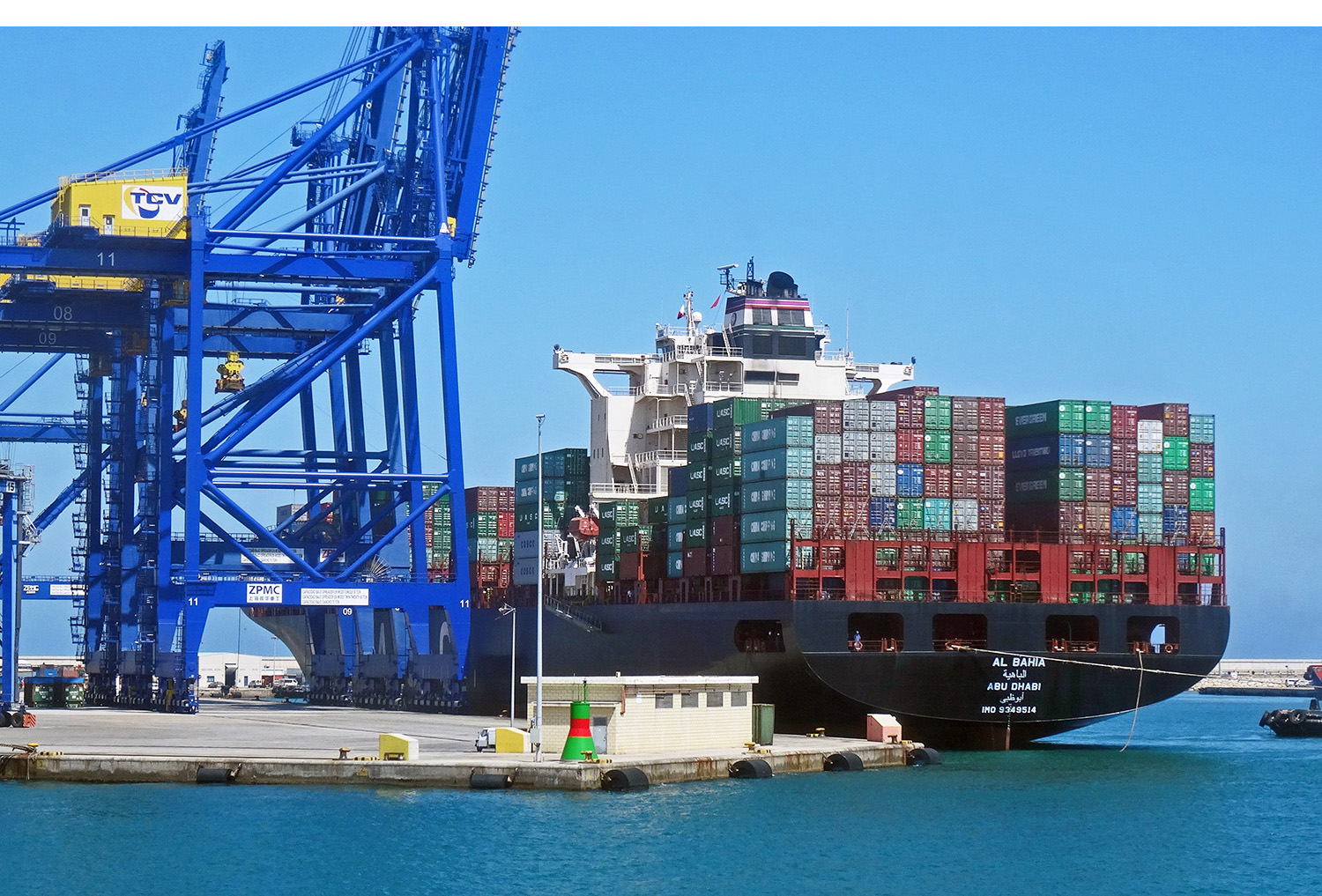 Even though the nature of the Brexit deal has been clear since it was signed in December 2020, assessing the impact of the extra barriers to trade it has created has been hard given the various shocks that have had a severe impact on the UK (and global) economy. First COVID-19 and the associated lockdowns had a direct effect on output and trade; second the longer-term international supply-chain disruptions have extended the COVID costs beyond the initial lockdowns and acted as a brake on recovery and growth; third the Russian invasion of Ukraine imposed a severe shock to energy and food markets; fourth these factors have created not just a supply shock but also an inflationary shock, which has resulted in central banks seeking to dampen demand by significantly raising interest rates. One worry among analysts was that the negative effects of such shocks might be greater on the UK economy than on other countries.
Even though the nature of the Brexit deal has been clear since it was signed in December 2020, assessing the impact of the extra barriers to trade it has created has been hard given the various shocks that have had a severe impact on the UK (and global) economy. First COVID-19 and the associated lockdowns had a direct effect on output and trade; second the longer-term international supply-chain disruptions have extended the COVID costs beyond the initial lockdowns and acted as a brake on recovery and growth; third the Russian invasion of Ukraine imposed a severe shock to energy and food markets; fourth these factors have created not just a supply shock but also an inflationary shock, which has resulted in central banks seeking to dampen demand by significantly raising interest rates. One worry among analysts was that the negative effects of such shocks might be greater on the UK economy than on other countries.
However, the negative effects of Brexit are now becoming clearer and various institutions have attempted to quantify the costs. These costs are largely in terms of lower GDP than otherwise. This results from:
- reduced levels of trade with the EU, thereby reducing the gains from exploiting comparative advantage;
- increased costs of trade with the EU;
- disruptions to supply chains;
- reduced competition from European firms, with many no longer exporting to the UK because of the costs;
- reduced inward investment;
- labour market shortages, particularly in certain areas such a hospitality, construction, social care and agriculture as many European workers have left the UK and fewer come;
- a reduction in productivity.
Here is a summary of the findings of different organisations.
The Office for Budget Responsibility (OBR)
The OBR has argued that Brexit as negotiated in the Trade and Cooperation Agreement:
will reduce long-run productivity by 4 per cent relative to remaining in the EU. This largely reflects our view that the increase in non-tariff barriers on UK-EU trade acts as an additional impediment to the exploitation of comparative advantage.21
In addition the OBR estimates that:
Both exports and imports will be around 15 per cent lower in the long run than if the UK had remained in the EU.21
Recent evidence supports this. According to the OBR:
UK and aggregate advanced economy goods export volumes fell by around 20 per cent during the initial wave of the pandemic in 2020. But by the fourth quarter of 2021 total advanced economy trade volumes had rebounded to 3 per cent above their pre-pandemic levels while UK exports remain around 12 per cent below.22
This assumption was repeated in the November 2022 Economic and Fiscal Outlook (p.26) 23. What is more, new trade deals will make little difference, either because they are a roll-over from previous EU trade deals with the respective country or have only a very small effect (e.g. the trade deal with Australia).
The Bank of England
The Bank of England, ever since the referendum in 2016, has forecast that Brexit would damage trade, productivity and GDP growth. In recent evidence to the House of Commons Treasury Committee5, Andrew Bailey, the Governor, stated that previous work by the Bank concluded that Brexit would reduce productivity by a bit over 3% and that this was still the Bank’s view.
His colleague, Dr Swati Dhingra, stated that, because of Brexit, there was a ‘much bigger slowdown in trade in the UK compared to the rest of the world’. She continued:
The simple way of thinking about what Brexit has done to the economy is that in the period after the referendum, the biggest depreciation that any of the world’s four major economies have seen overnight contributed to increasing prices [and] reduced wages. …We think that number is about 2.6% below the trend that real wages would have been on. Soon afterwards and before the TCA happened came the effects of the uncertainty that was unleashed, which basically translates into reduced business investment and less certainty of the FDI effects. Those tend to be very long-pay things.
She continued that now we are seeing significantly reduced trade directly as a result of the Brexit trade agreement (TCA).
Her colleague, Dr Catherine Mann, argued that ‘the small firms are the ones that are the most damaged, because the cost of the paperwork and so forth is a barrier’. This does not only affect UK firms exporting to the EU but also EU firms exporting to the UK. Reduced imports from EU firms reduces competition in the UK, which tends to lead to higher prices.
The Institute for Fiscal Studies
The IFS has consistently argued that Brexit, because of increased trade barriers with the EU, has reduced UK trade, productivity and GDP. In a recent interview6, its Director, Paul Johnson, stated that ‘Brexit, without doubt, has made us poorer than we would otherwise have been’. That, plus other convulsions, such as the mini-Budget of October 2022, have reduced foreigners’ confidence in the UK, with the result that investment in the UK and trade with the rest of the world have fallen.
Resolution Foundation
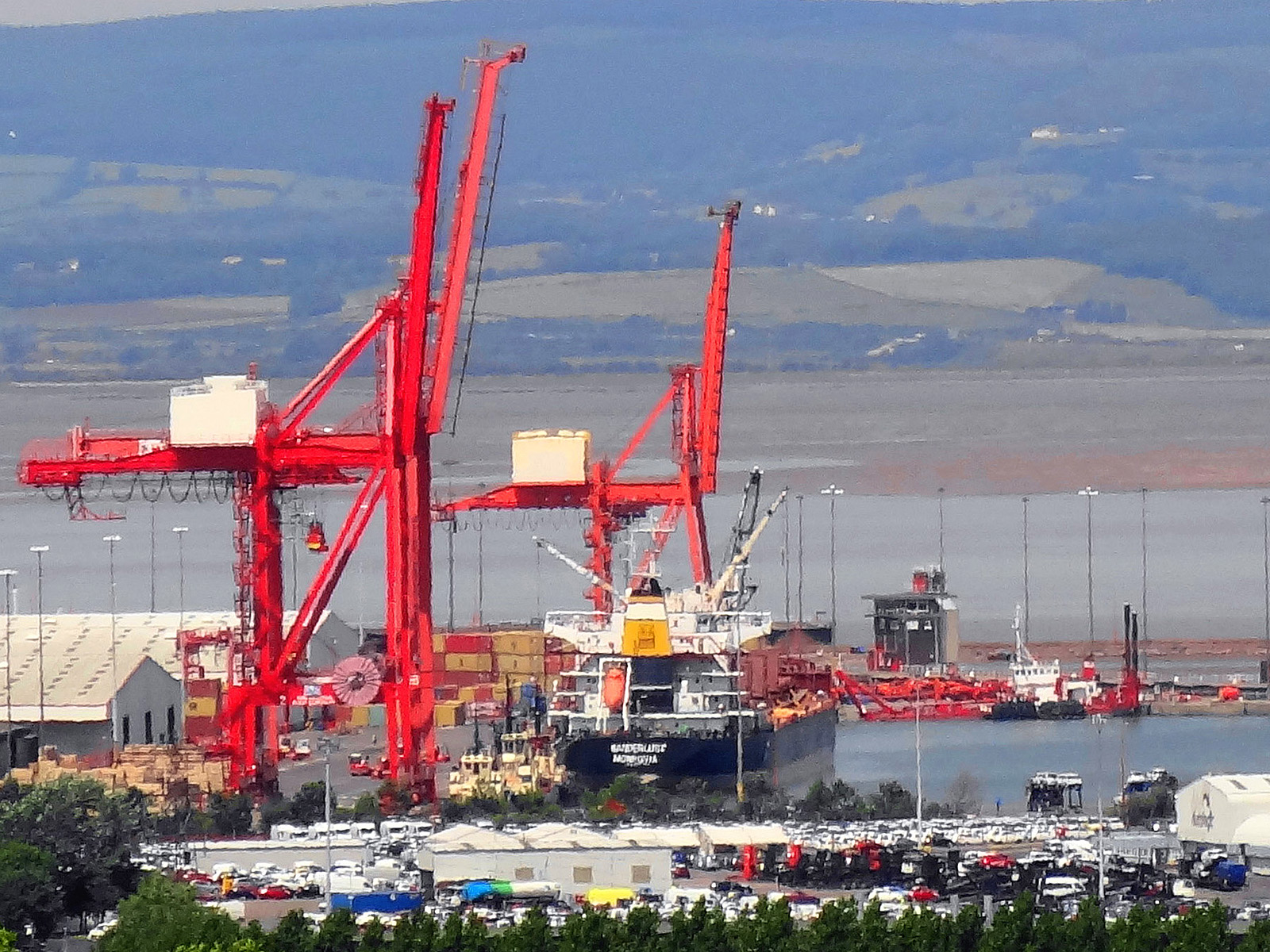 In a major Resolution Foundation report24, the authors argued that the effects of Brexit will take time to materialise fully and will occur in three distinct phases. First, in anticipation of permanent effects, the referendum caused sterling to depreciate and this adversely affected household incomes. What is more, the uncertainty about the future caused business investment to fall (but not inward FDI). Second, the Trade and Cooperation Act, by introducing trade barriers, reduced UK trade with the EU. But trade with the rest of the world also fell suggesting that Brexit is impacting UK trade openness and competitiveness more broadly. Third, there will be structural changes to the UK economy over the long-term which will adversely affect economic growth:
In a major Resolution Foundation report24, the authors argued that the effects of Brexit will take time to materialise fully and will occur in three distinct phases. First, in anticipation of permanent effects, the referendum caused sterling to depreciate and this adversely affected household incomes. What is more, the uncertainty about the future caused business investment to fall (but not inward FDI). Second, the Trade and Cooperation Act, by introducing trade barriers, reduced UK trade with the EU. But trade with the rest of the world also fell suggesting that Brexit is impacting UK trade openness and competitiveness more broadly. Third, there will be structural changes to the UK economy over the long-term which will adversely affect economic growth:
A less-open UK will mean a poorer and less productive one by the end of the decade, with real wages expected to fall by 1.8 per cent, a loss of £470 per worker a year, and labour productivity by 1.3 per cent, as a result of the long-run changes to trade under the TCA. This would be equivalent to losing more than a quarter of the last decade’s productivity growth.
Nuffield Trust
One of the key effects of Brexit has been on the labour market and especially on sectors, such as hospitality, agriculture, construction, health and social care. These sectors are experiencing labour shortages, in part due to EU nationals leaving the UK. In 2021, the Nuffield Trust looked at the supply of workers in health and social care25 and found that, as a result of increased bureaucratic hurdles, the number of EU/EFTA-trained nurses had declined since 2016. In social care, new immigration rules have made it virtually impossible to recruit from the EU. A more recent report looked at the recruitment of doctors in four specific specialties.26 In each case, although the number recruited from the EU/EFTA was still increasing, the rate of increase had slowed significantly. The reason appeared to be Brexit not COVID-19.
Ivalua
Research by Coleman Parkes for Ivalua18 shows that 80% of firms found Brexit to have been the biggest cause of supply-chain disruptions in the 12 months to August 2022, with 83% fearing the biggest disruptions from Brexit are yet to come. Brexit was found to have had a bigger effect on supply chains than the war in Ukraine, rising energy costs and COVID-19.
Centre for European Reform
Modelling conducted by John Springford27 used a ‘doppelgängers’ method to show the effects of Brexit on the UK economy. Each doppelgänger is ‘a basket of countries whose economic performance closely matches the UK’s before the Brexit referendum and the end of the transition period’. Comparing the UK’s performance with the doppelgänger can show the difference between leaving and not leaving the UK. Doppelgängers were estimated for GDP, investment (gross fixed capital formation), total services trade (exports plus imports) and total goods trade (ditto).
The results are sobering. In the final quarter of 2021, UK GDP is 5.2 per cent smaller than the modelled, doppelgänger UK; investment is 13.7 per cent lower; and goods trade, 13.6 per cent lower.
Economic and Social Research Institute (ESRI) (Ireland)
Similar results for UK trade have been obtained by Janez Kren and Martina Lawless in research conducted for the ESRI.28 They used product-level trade flows between the EU and all other countries in the world as a comparison group. This showed a 16% reduction in UK exports to the EU and a 20% reduction in UK imports from the EU relative to the scenario in which Brexit had not occurred.
British Chambers of Commerce (BCC) survey
According to a BCC survey of 1168 businesses33, 92% of which are SMEs, more than three quarters (77%) for which the Brexit deal is applicable say it is not helping them increase sales or grow their business and 56% say they have difficulties in adapting to the new rules for trading goods. The survey shows that UK firms are facing significant challenges in trying to trade with EU countries under the terms of the Trade and Cooperation Agreement. What is more, 80% of firms had seen the cost of importing increase; 53% had seen their sales margins decrease; and almost 70% of manufacturers had experienced shortages of goods and services from the EU.
Academic studies
Research at the Centre for Business Prosperity, Aston University, by Jun Du, Emine Beyza Satoglu and Oleksandr Shepotylo20, 29 found that UK exports to the EU ‘fell by an average of 22.9% in the first 15 months after the introduction of the EU-UK Trade and Cooperation Agreement’. The negative effect on UK exports persisted and deepened from January 2021 to March 2022. The research involved comparing actual trade with an ‘alternative UK economy’ model based on the UK having remained in the EU. What is more, the researchers found that there had been a reduction of 42% in the number of product varieties exported to the EU, with a large number of exporters simply ceasing to export to the EU and with many of the remaining exporters streamlining their product ranges.
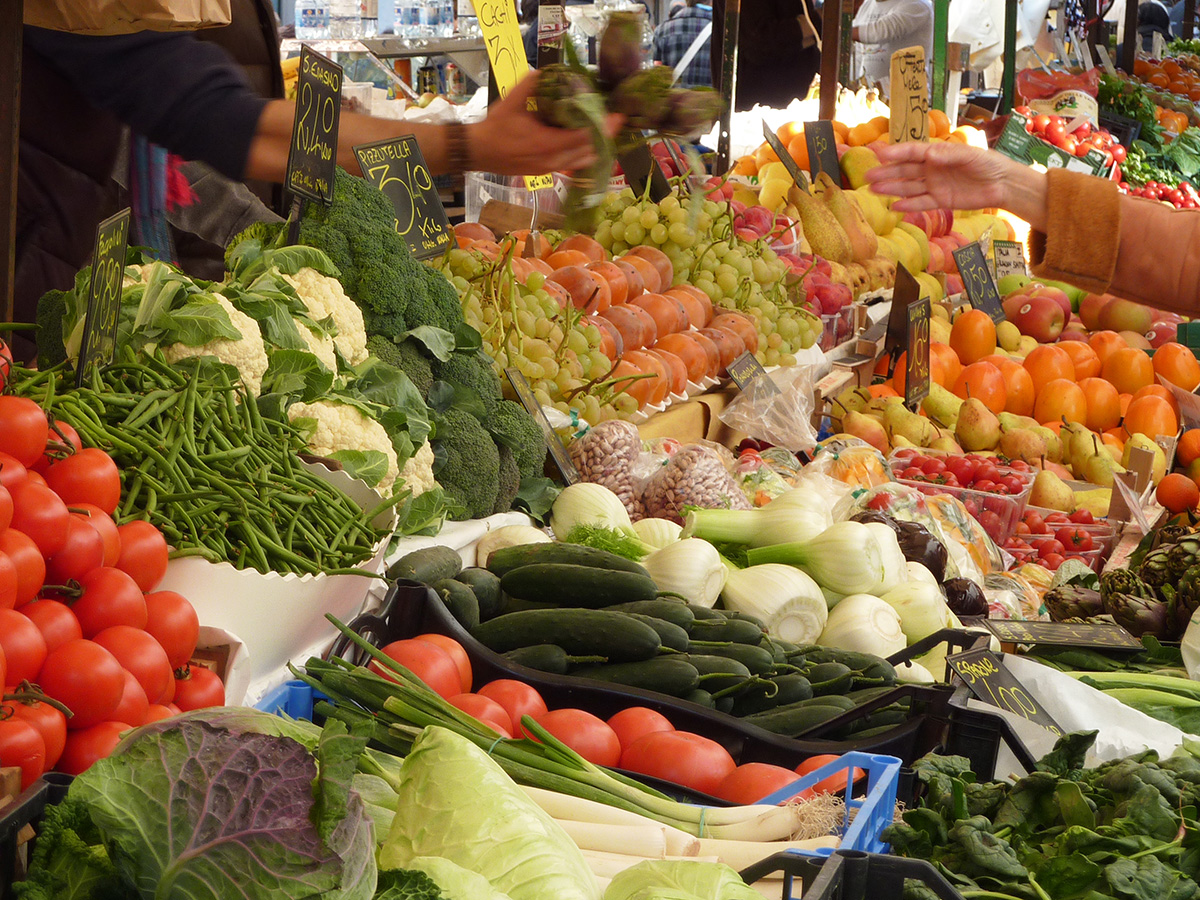 Research at the LSE’s Centre for Economic Performance by Jan David Bakker, Nikhil Datta, Richard Davies and Josh De Lyon31 found that leaving the EU added an average of £210 to UK household food bills over the two years to the end of 2021. This amounted to a total cost to consumers of £5.8 billion. This confirmed the findings of previous research30 that the increase in UK-EU trade barriers led to food prices in the UK being 6% higher than they would have been.
Research at the LSE’s Centre for Economic Performance by Jan David Bakker, Nikhil Datta, Richard Davies and Josh De Lyon31 found that leaving the EU added an average of £210 to UK household food bills over the two years to the end of 2021. This amounted to a total cost to consumers of £5.8 billion. This confirmed the findings of previous research30 that the increase in UK-EU trade barriers led to food prices in the UK being 6% higher than they would have been.
Finally, a report from the Migration Observatory at the University of Oxford32 examined the effects of the ending of the free movement of labour from the EU to the UK. Visas are now required, but ‘low-wage occupations that used to rely heavily on EU workers are now ineligible for work visas, with some limited exceptions for social care and seasonal workers’. Many industries are facing labour shortages. Reasons include other factors, such as low pay and unattractive working conditions, and workers leaving the workforce during the pandemic and afterwards. But the end of free movement appears to have exacerbated these existing problems.
References
Videos
 The Brexit effect: how leaving the EU hit the UK
The Brexit effect: how leaving the EU hit the UKFinancial Times film (18/10/22)
 What impact is Brexit having on the UK economy?
What impact is Brexit having on the UK economy?Brexit and the UK economy, Ros Atkins (29/10/22)
 Why Brexit is damaging the UK economy both now and in the future
Why Brexit is damaging the UK economy both now and in the futureEconomics Help on YouTube, Tejvan Pettinger (5/12/22)
 Why the Costs of Brexit keep growing for the UK economy
Why the Costs of Brexit keep growing for the UK economyEconomics Help on YouTube, Tejvan Pettinger (17/10/22)
 Treasury Committee (see also)
Treasury Committee (see also)Parliament TV (25/11/22) (see 15:03:00 to 15:08:12) (Click here for a transcript: see Q637 to Q641)
 UK economy made worse by ‘own goals’ like Brexit and Truss mini-budget, IFS economist says
UK economy made worse by ‘own goals’ like Brexit and Truss mini-budget, IFS economist saysSky News, Paul Johnson (IFS) (18/11/22)
Articles
- Brexit and the economy: the hit has been ‘substantially negative’
Financial Times, Chris Giles (30/11/22)
- ‘What have we done?’: six years on, UK counts the cost of Brexit
The Observer, Toby Helm, Robin McKie, James Tapper & Phillip Inman (25/6/22)
- Brexit did hurt the City’s exports – the numbers don’t lie
Financial News, David Wighton (9/11/22)
- Brits are starting to think again about Brexit as the economy slides into recession
CNBC, Elliot Smith (23/11/22)
- Brexit has cracked Britain’s economic foundations
CNN, Hanna Ziady (24/12/22)
- Mark Carney: ‘Doubling down on inequality was a surprising choice’
Financial Times, Edward Luce (14/10/22)
- Brexit: Progress on trade deals slower than promised
BBC News, Ione Wells & Brian Wheeler (2/12/22)
- How Brexit costs this retailer £1m a month in sales
BusinessLive, Tom Pegden (22/11/22)
- Brexit Is Hurting The UK Economy, Bank Of England Official Says
HuffPost, Graeme Demianyk (16/11/22)
- Brexit and drop in workforce harming economic recovery, says Bank governor
The Guardian, Richard Partington (16/11/22)
- Brexit a major cause of UK’s return to austerity, says senior economist
The Guardian, Anna Isaac (14/11/22)
- 80% of UK businesses say Brexit caused the biggest supply chain disruption in the last 12 months
Ivalua (28/11/22)
- Brexit added £210 to household food bills, new research finds
Sky News, Faye Brown (1/12/22)
- Brexit changes caused 22.9% slump in UK-EU exports into Q1 2022 – research
Expertfile (8/12/22)
Research and analysis
- Brexit analysis
OBR (26/5/22)
- The latest evidence on the impact of Brexit on UK trade
OBR (March 2022)
- Economic and fiscal outlook – November 2022 (PDF)
OBR (17/11/22)
- The Big Brexit (PDF)
Resolution Foundation, Swati Dhingra, Emily Fry, Sophie Hale & Ningyuan Jia (June 2022)
- Going it alone: health and Brexit in the UK
Nuffield Trust, Mark Dayan, Martha McCarey, Tamara Hervey, Nick Fahy, Scott L Greer, Holly Jarman, Ellen Stewart and Dan Bristow (20/12/21)
- Has Brexit affected the UK’s medical workforce?
Nuffield Trust, Martha McCarey and Mark Dayan (27/11/22)
- What can we know about the cost of Brexit so far?
Centre for European Reform, John Springford (9/6/22)
- Brexit reduced overall EU-UK goods trade flows by almost one-fifth
Economic and Social Research Institute (Ireland), Janez Kren and Martina Lawless (19/10/22)
- Post-Brexit UK Trade – An Update (PDF)
Centre for Business Prosperity, Aston University, Jun Du, Emine Beyza Satoglu and Oleksandr Shepotylo (November 2022)
- Post-Brexit imports, supply chains, and the effect on consumer prices (PDF)
UK in a Changing Europe, Jan David Bakker, Nikhil Datta, Josh De Lyon, Luisa Opitz and Dilan Yang (25/4/22)
- Non-tariff barriers and consumer prices: evidence from Brexit
Centre for Economic Performance, LSE, Jan David Bakker, Nikhil Datta, Richard Davies and Josh De Lyon (December 2022)
- How is the End of Free Movement Affecting the Low-wage Labour Force in the UK?
Migration Observatory, University of Oxford, Madeleine Sumption, Chris Forde, Gabriella Alberti and Peter William Walsh (15/8/22)
- The Trade and Cooperation Agreement: Two Years On – Proposals For Reform by UK Business
British Chambers of Commerce (21/12/22)
- The Detriments of Brexit
Yorkshire Bylines (June 2022) (see also)
Questions
- Summarise the negative effects of Brexit on the UK economy.
- Why is it difficult to quantify these effects?
- Explain the ‘doppelgängers’ method of estimating the costs of Brexit? How reliable is this method likely to be?
- How have UK firms attempted to reduce the costs of exporting to the EU?
- Is Brexit the sole cause of a shortage of labour in many sectors in the UK?
 The suffering inflicted on the Ukrainian people by the Russian invasion is immense. But, at a much lower level, the war will also inflict costs on people in countries around the world. There will be significant costs to households in the form of even higher energy and food price inflation and a possible economic slowdown. The reactions of governments and central banks could put a further squeeze on living standards. Stock markets could fall further and investment could decline as firms lose confidence.
The suffering inflicted on the Ukrainian people by the Russian invasion is immense. But, at a much lower level, the war will also inflict costs on people in countries around the world. There will be significant costs to households in the form of even higher energy and food price inflation and a possible economic slowdown. The reactions of governments and central banks could put a further squeeze on living standards. Stock markets could fall further and investment could decline as firms lose confidence.
Russia is the world’s second largest oil supplier and any disruption to supplies will drive up the price of oil significantly. Ahead of the invasion, oil prices were rising. At the beginning of February, Brent crude was around $90 per barrel. With the invasion, it rose above $100 per barrel.
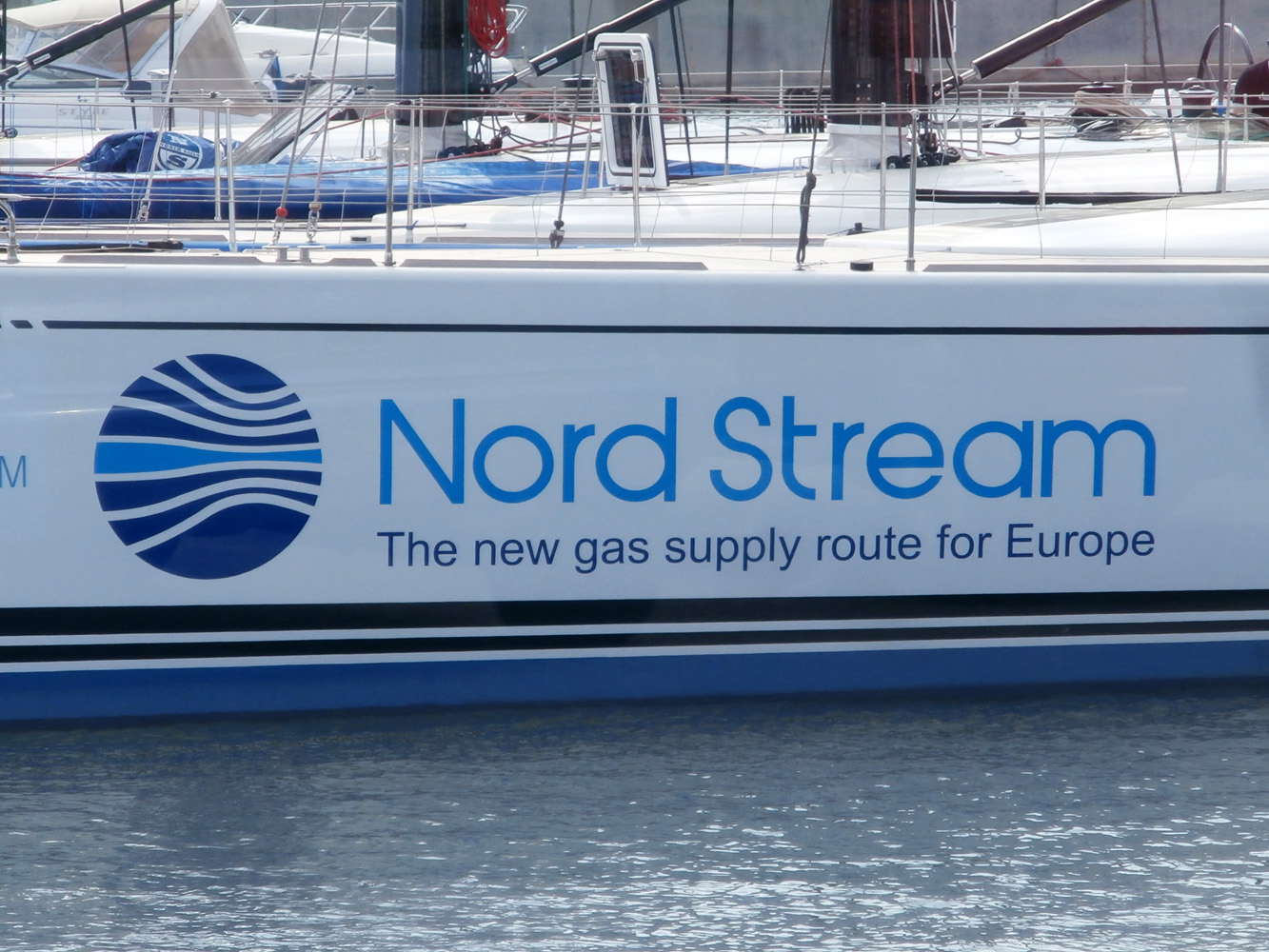 Russia is also a major producer of natural gas. The EU is particularly dependent on Russia, which supplies 40% of its natural gas. With Germany halting approval of the major new gas pipeline under the Baltic from Russia to Germany, Nord Stream 2, the price of gas has rocketed. On the day of the invasion, European gas prices rose by over 50%.
Russia is also a major producer of natural gas. The EU is particularly dependent on Russia, which supplies 40% of its natural gas. With Germany halting approval of the major new gas pipeline under the Baltic from Russia to Germany, Nord Stream 2, the price of gas has rocketed. On the day of the invasion, European gas prices rose by over 50%.
Nevertheless, with the USA deciding not to extend sanctions to Russia’s energy sector, the price of gas fell back by 32% the next day. It remains to be seen just how much the supplies of oil and gas from Russia will be disrupted over the coming weeks.
Both Russia and Ukraine are major suppliers of wheat and maize, between them responsible for 14% of global wheat production and 30% of global wheat exports. A significant rise in the price of wheat and other grains will exacerbate the current rise in food price inflation.
Russia is also a significant supplier of metals, such as copper, platinum, aluminium and nickel, which are used in a wide variety of products. A rise in their price has begun and will further add to inflationary pressures and supply-chain problems which have followed the pandemic.
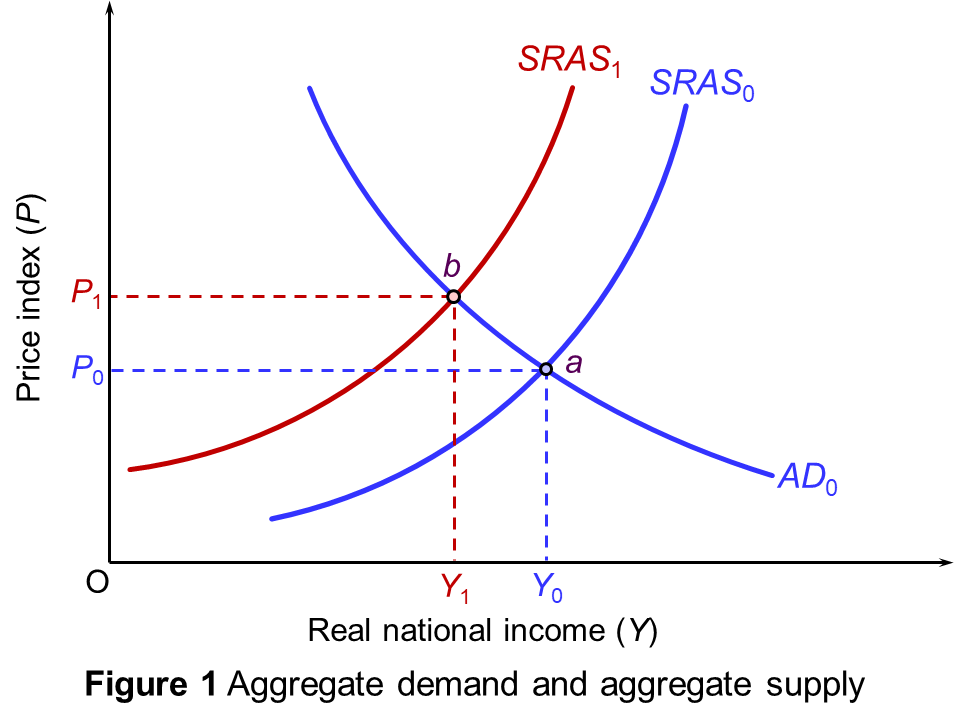 The effect of these supply shocks can be illustrated in a simple aggregate demand and supply diagram (see Figure 1), which shows a representative economy that imports energy, grain and other resources. Aggregate demand and short-run aggregate supply are initially given by AD0 and SRAS0. Equilibrium is at point a, with real national income (real GDP) of Y0 and a price index of P0.
The effect of these supply shocks can be illustrated in a simple aggregate demand and supply diagram (see Figure 1), which shows a representative economy that imports energy, grain and other resources. Aggregate demand and short-run aggregate supply are initially given by AD0 and SRAS0. Equilibrium is at point a, with real national income (real GDP) of Y0 and a price index of P0.
The supply shock shifts short-run aggregate supply to SRAS1. Equilibrium moves to point b. The price index rises to P1 and real national income falls to Y1. If it is a ‘one-off’ cost increase, then the price index will settle at the new higher level and GDP at the new lower level provided that real aggregate demand remains the same. Inflation will be temporary. If, however, the SRAS curve continues to shift upwards to the left, then cost-push inflation will continue.
These supply-side shocks make the resulting inflation hard for policymakers to deal with. When the problem lies on the demand side, where the inflation is accompanied by an unsustainable boom, a contractionary fiscal and monetary policy can stabilise the economy and reduce inflation. But the inflationary problem today is not demand-pull inflation; it’s cost-push inflation. Disruptions to supply are both driving up prices and causing an economic slowdown – a situation of ‘stagflation’, or even an inflationary recession.
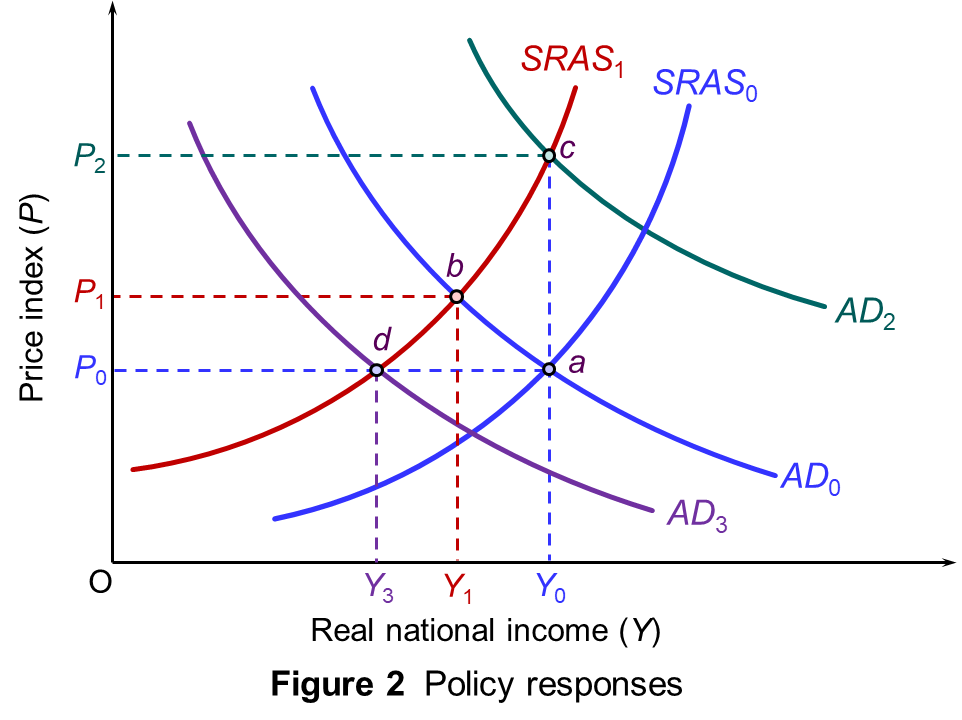 An expansionary policy, such as increasing bond purchases (quantitative easing) or increasing government spending, may help to avoid recession (at least temporarily), but will only exacerbate inflation. In Figure 2, aggregate demand shifts to AD2. Equilibrium moves to point c. Real GDP returns to Y0 (at least temporarily) but the price level rises further, to P2. (Click here for a PowerPoint of the diagram.)
An expansionary policy, such as increasing bond purchases (quantitative easing) or increasing government spending, may help to avoid recession (at least temporarily), but will only exacerbate inflation. In Figure 2, aggregate demand shifts to AD2. Equilibrium moves to point c. Real GDP returns to Y0 (at least temporarily) but the price level rises further, to P2. (Click here for a PowerPoint of the diagram.)
A contractionary policy, such as raising interest rates or taxes, may help to reduce inflation but will make the slowdown worse and could lead to recession. In the diagram, aggregate demand shifts to AD3. Equilibrium moves to point d. The price level returns to P0 (at least temporarily) but real income falls further, to Y3.
In other words, you cannot tackle both the slowdown/recession and the inflation simultaneously by the use of demand-side policy. One requires an expansionary fiscal and/or monetary policy; the other requires fiscal and/or monetary tightening.
Then there are other likely economic stresses. If NATO countries respond by increasing defence expenditure, this will put further strain on public finances.
Sentiment is a key driver of the economy and prices. Expectations tend to be self-fulfilling. So if the war in Ukraine undermines confidence in stock markets and the real economy and further raises inflationary expectations, this pessimistic mood will tend in itself to drive down share prices, drive up inflation and drive down investment and economic growth.
Articles
- How will Russia’s invasion of Ukraine hit the global economy?
Financial Times, Chris Giles, Jonathan Wheatley and Valentina Romei (25/2/22)
- Ukraine conflict raises the possibility of stagflation
Financial Times, The Editorial Board (25/2/22)
- Five ways the Ukraine war could push up prices
BBC News, Laura Jones (5/3/22)
- Jason Furman cautions against reading too much into the initial market reactions to Russia’s invasion
interest.co.nz, Jason Furman (26/2/22)
- Putin’s war promises to crush the global economy with inflation and much slower growth
Market Watch, Nouriel Roubini (25/2/22)
- Roubini: 6 Financial, Economic Risks of Russia-Ukraine War
ThinkAdvisor, Janet Levaux (25/2/22)
- Fed tightening plans now contending with war, possible oil shock
Reuters, Howard Schneider and Jonnelle Marte (24/2/22)
- The invasion of Ukraine changed everything for Wall Street
CNN, Julia Horowitz (27/2/22)
- Why the Russian invasion will have huge economic consequences for American families
CNN, Matt Egan (24/2/22)
- European gas prices soar and oil tops $105 after Russia attacks Ukraine
Financial Times, Neil Hume, Emiko Terazono and Tom Wilson (24/2/22)
- Five essential commodities that will be hit by war in Ukraine
The Conversation, Sarah Schiffling and Nikolaos Valantasis Kanellos (24/2/22)
- Ukraine: ‘I’m surprised the oil price hasn’t hit US$130 a barrel yet’ – energy trading expert Q&A
The Conversation, Adi Imsirovic (25/2/22)
- Ukraine crisis: Warning UK energy bills could top £3,000 a year
BBC News, Michael Race (25/2/22)
- Putin’s energy shock: The economic realities of invasion
BBC News, Faisal Islam (25/2/22)
- Fears of UK food and fuel prices rising due to war
BBC News, Oliver Smith & Michael Race (26/2/22)
- Ukraine conflict: What is Swift and why is banning Russia so significant?
BBC News, Russell Hotten (27/2/22)
- Ukraine conflict: How reliant is Europe on Russia for oil and gas?
BBC News, Jake Horton & Daniele Palumbo (25/2/22)
- Ukraine crisis complicates ECB’s path to higher rates
Reuters, Francesco Canepa and Balazs Koranyi (24/2/22)
- Russia and the West are moving towards all out economic war
Al Jazeera, Maximilian Hess (24/2/22)
Questions
- If there is a negative supply shock, what will determine the size of the resulting increase in the price level and the rate of inflation over the next one or two years?
- How may expectations affect (a) the size of the increase in the price level; (b) future prices of gas and oil?
- Why did stock markets rise on the day after the invasion of Ukraine?
- Argue the case for and against relaxing monetary policy and delaying tax rises in the light of the economic consequences of the war in Ukraine.
 According to the IMF, Chinese GDP grew by 5.2% in 2023 and is predicted to grow by 4.6% this year. Such growth rates would be extremely welcome to most developed countries. UK growth in 2023 was a mere 0.5% and is forecast to be only 0.6% in 2024. Advanced economies as a whole only grew by 1.6% in 2023 and are forecast to grow by only 1.5% this year. Also, with the exception of India, the Philippines and Indonesia, which grew by 6.7%, 5.3% and 5.0% respectively in 2023 and are forecast to grow by 6.5%, 6.0% and 5.0% this year, Chinese growth also compares very favourably with other developing countries, which as a weighted average grew by 4.1% last year and are forecast to grow at the same rate this year.
According to the IMF, Chinese GDP grew by 5.2% in 2023 and is predicted to grow by 4.6% this year. Such growth rates would be extremely welcome to most developed countries. UK growth in 2023 was a mere 0.5% and is forecast to be only 0.6% in 2024. Advanced economies as a whole only grew by 1.6% in 2023 and are forecast to grow by only 1.5% this year. Also, with the exception of India, the Philippines and Indonesia, which grew by 6.7%, 5.3% and 5.0% respectively in 2023 and are forecast to grow by 6.5%, 6.0% and 5.0% this year, Chinese growth also compares very favourably with other developing countries, which as a weighted average grew by 4.1% last year and are forecast to grow at the same rate this year. But in the past, Chinese growth was much higher and was a major driver of global growth. Over the period 1980 to 2018, Chinese economic growth averaged 9.5% – more than twice the average rate of developing countries (4.5%) and nearly four times the average rate of advanced countries (2.4%) (see chart – click here for a PowerPoint of the chart).
But in the past, Chinese growth was much higher and was a major driver of global growth. Over the period 1980 to 2018, Chinese economic growth averaged 9.5% – more than twice the average rate of developing countries (4.5%) and nearly four times the average rate of advanced countries (2.4%) (see chart – click here for a PowerPoint of the chart). Property market
Property market Lack of confidence in the Chinese economy is reflected in falling share prices. The Shanghai SSE Composite Index (an index of all stocks traded on the Shanghai Stock Exchange) has fallen dramatically in recent months. From a high of 3703 in September 2021, it had fallen to 2702 on 5 Feb 2024 – a fall of 27%. It is now below the level at the beginning of 2010 (see chart: click here for a PowerPoint). On 5 February alone, some 1800 stocks fell by over 10% in Shanghai and Shenzhen. People were sensing a rout and investors expressed their frustration and anger on social media, including the social media account of the US Embassy. The next day, the authorities intervened and bought large quantities of key stocks. China’s sovereign wealth fund announced that it would increase its purchase of shares to support the country’s stock markets. The SSE Composite rose 4.1% on 6 February and the Shenzhen Component Index rose 6.2%.
Lack of confidence in the Chinese economy is reflected in falling share prices. The Shanghai SSE Composite Index (an index of all stocks traded on the Shanghai Stock Exchange) has fallen dramatically in recent months. From a high of 3703 in September 2021, it had fallen to 2702 on 5 Feb 2024 – a fall of 27%. It is now below the level at the beginning of 2010 (see chart: click here for a PowerPoint). On 5 February alone, some 1800 stocks fell by over 10% in Shanghai and Shenzhen. People were sensing a rout and investors expressed their frustration and anger on social media, including the social media account of the US Embassy. The next day, the authorities intervened and bought large quantities of key stocks. China’s sovereign wealth fund announced that it would increase its purchase of shares to support the country’s stock markets. The SSE Composite rose 4.1% on 6 February and the Shenzhen Component Index rose 6.2%.  China has seen investment in education as an important means of increasing human capital and growth. But with a slowing economy, there are are more young people graduating each year than there are graduate jobs available. Official data show that for the group aged 16–24, the unemployment rate was 14.9% in December. This compares with an overall urban unemployment rate of 5.1%. Many graduates are forced to take non-graduate jobs and graduate jobs are being offered at reduced salaries. This will have a further dampening effect on aggregate demand.
China has seen investment in education as an important means of increasing human capital and growth. But with a slowing economy, there are are more young people graduating each year than there are graduate jobs available. Official data show that for the group aged 16–24, the unemployment rate was 14.9% in December. This compares with an overall urban unemployment rate of 5.1%. Many graduates are forced to take non-graduate jobs and graduate jobs are being offered at reduced salaries. This will have a further dampening effect on aggregate demand. Evergrande liquidation: What’s behind China’s biggest corporate fail ever
Evergrande liquidation: What’s behind China’s biggest corporate fail ever Is China’s economy in serious trouble?
Is China’s economy in serious trouble? China’s stock market bounce is ‘short-term exuberance’, says Longview Global’s Dewardric McNeal
China’s stock market bounce is ‘short-term exuberance’, says Longview Global’s Dewardric McNeal China has been an economic powerhouse in recent decades – a powerhouse that has helped to drive the world economy through trade and both inward and outward investment. At the same time, its low-priced exports have helped to dampen world inflation. But is all this changing? Is China, to use President Biden’s words, a ‘ticking time bomb’?
China has been an economic powerhouse in recent decades – a powerhouse that has helped to drive the world economy through trade and both inward and outward investment. At the same time, its low-priced exports have helped to dampen world inflation. But is all this changing? Is China, to use President Biden’s words, a ‘ticking time bomb’? One of the biggest worries for the Chinese economy is the property market. The annual rate of property investment fell by 20.6% in June this year and
One of the biggest worries for the Chinese economy is the property market. The annual rate of property investment fell by 20.6% in June this year and  The fall in demand has caused consumer prices to fall. In the year to July 2023, they fell by 0.3%. Even though core inflation is still positive (0.8%), the likelihood of price reductions in the near future discourages spending as people hold back, waiting for prices to fall further. This further dampens the economy. This is a problem that was experienced in Japan over many years.
The fall in demand has caused consumer prices to fall. In the year to July 2023, they fell by 0.3%. Even though core inflation is still positive (0.8%), the likelihood of price reductions in the near future discourages spending as people hold back, waiting for prices to fall further. This further dampens the economy. This is a problem that was experienced in Japan over many years. Over the decades, economies have become increasingly interdependent. This process of globalisation has involved a growth in international trade, the spread of technology, integrated financial markets and international migration.
Over the decades, economies have become increasingly interdependent. This process of globalisation has involved a growth in international trade, the spread of technology, integrated financial markets and international migration. According to the Office for Budget Responsibility’s November 2022 Economic and Fiscal Outlook, Brexit will result in the UK’s trade intensity being 15 per cent lower in the long run than if it had remained in the EU.
According to the Office for Budget Responsibility’s November 2022 Economic and Fiscal Outlook, Brexit will result in the UK’s trade intensity being 15 per cent lower in the long run than if it had remained in the EU.  But trade can increase dependence on unreliable supply sources. For example, at present, some companies are seeking to reduce their reliance on Taiwanese parts, given worries about possible Chinese actions against Taiwan.
But trade can increase dependence on unreliable supply sources. For example, at present, some companies are seeking to reduce their reliance on Taiwanese parts, given worries about possible Chinese actions against Taiwan.  The problems with a globally interdependent world have led to world trade growing more slowly than world GDP in recent years after decades of trade growth considerably outstripping GDP growth. Trade (imports plus exports) as a percentage of GDP peaked at just over 60% in 2008. In 2019 and 2021 it was just over 56%. This is illustrated in the chart (click
The problems with a globally interdependent world have led to world trade growing more slowly than world GDP in recent years after decades of trade growth considerably outstripping GDP growth. Trade (imports plus exports) as a percentage of GDP peaked at just over 60% in 2008. In 2019 and 2021 it was just over 56%. This is illustrated in the chart (click  At the time of the 2016 referendum, the clear consensus among economists was that Brexit would impose net economic costs on the UK economy. The size of these costs would depend on the nature of post-Brexit trading relations with the EU. The fewer the new barriers to trade and the closer the alignment with the EU single market, the lower these costs would be.
At the time of the 2016 referendum, the clear consensus among economists was that Brexit would impose net economic costs on the UK economy. The size of these costs would depend on the nature of post-Brexit trading relations with the EU. The fewer the new barriers to trade and the closer the alignment with the EU single market, the lower these costs would be. Even though the nature of the Brexit deal has been clear since it was signed in December 2020, assessing the impact of the extra barriers to trade it has created has been hard given the various shocks that have had a severe impact on the UK (and global) economy. First COVID-19 and the associated lockdowns had a direct effect on output and trade; second the longer-term international supply-chain disruptions have extended the COVID costs beyond the initial lockdowns and acted as a brake on recovery and growth; third the Russian invasion of Ukraine imposed a severe shock to energy and food markets; fourth these factors have created not just a supply shock but also an inflationary shock, which has resulted in central banks seeking to dampen demand by significantly raising interest rates. One worry among analysts was that the negative effects of such shocks might be greater on the UK economy than on other countries.
Even though the nature of the Brexit deal has been clear since it was signed in December 2020, assessing the impact of the extra barriers to trade it has created has been hard given the various shocks that have had a severe impact on the UK (and global) economy. First COVID-19 and the associated lockdowns had a direct effect on output and trade; second the longer-term international supply-chain disruptions have extended the COVID costs beyond the initial lockdowns and acted as a brake on recovery and growth; third the Russian invasion of Ukraine imposed a severe shock to energy and food markets; fourth these factors have created not just a supply shock but also an inflationary shock, which has resulted in central banks seeking to dampen demand by significantly raising interest rates. One worry among analysts was that the negative effects of such shocks might be greater on the UK economy than on other countries. In a major Resolution Foundation report24, the authors argued that the effects of Brexit will take time to materialise fully and will occur in three distinct phases. First, in anticipation of permanent effects, the referendum caused sterling to depreciate and this adversely affected household incomes. What is more, the uncertainty about the future caused business investment to fall (but not inward FDI). Second, the Trade and Cooperation Act, by introducing trade barriers, reduced UK trade with the EU. But trade with the rest of the world also fell suggesting that Brexit is impacting UK trade openness and competitiveness more broadly. Third, there will be structural changes to the UK economy over the long-term which will adversely affect economic growth:
In a major Resolution Foundation report24, the authors argued that the effects of Brexit will take time to materialise fully and will occur in three distinct phases. First, in anticipation of permanent effects, the referendum caused sterling to depreciate and this adversely affected household incomes. What is more, the uncertainty about the future caused business investment to fall (but not inward FDI). Second, the Trade and Cooperation Act, by introducing trade barriers, reduced UK trade with the EU. But trade with the rest of the world also fell suggesting that Brexit is impacting UK trade openness and competitiveness more broadly. Third, there will be structural changes to the UK economy over the long-term which will adversely affect economic growth: Research at the LSE’s Centre for Economic Performance by Jan David Bakker, Nikhil Datta, Richard Davies and Josh De Lyon31 found that leaving the EU added an average of £210 to UK household food bills over the two years to the end of 2021. This amounted to a total cost to consumers of £5.8 billion. This confirmed the findings of previous research30 that the increase in UK-EU trade barriers led to food prices in the UK being 6% higher than they would have been.
Research at the LSE’s Centre for Economic Performance by Jan David Bakker, Nikhil Datta, Richard Davies and Josh De Lyon31 found that leaving the EU added an average of £210 to UK household food bills over the two years to the end of 2021. This amounted to a total cost to consumers of £5.8 billion. This confirmed the findings of previous research30 that the increase in UK-EU trade barriers led to food prices in the UK being 6% higher than they would have been. The suffering inflicted on the Ukrainian people by the Russian invasion is immense. But, at a much lower level, the war will also inflict costs on people in countries around the world. There will be significant costs to households in the form of even higher energy and food price inflation and a possible economic slowdown. The reactions of governments and central banks could put a further squeeze on living standards. Stock markets could fall further and investment could decline as firms lose confidence.
The suffering inflicted on the Ukrainian people by the Russian invasion is immense. But, at a much lower level, the war will also inflict costs on people in countries around the world. There will be significant costs to households in the form of even higher energy and food price inflation and a possible economic slowdown. The reactions of governments and central banks could put a further squeeze on living standards. Stock markets could fall further and investment could decline as firms lose confidence. Russia is also a major producer of natural gas. The EU is particularly dependent on Russia, which supplies 40% of its natural gas. With Germany halting approval of the major new gas pipeline under the Baltic from Russia to Germany, Nord Stream 2, the price of gas has rocketed. On the day of the invasion, European gas prices rose by over 50%.
Russia is also a major producer of natural gas. The EU is particularly dependent on Russia, which supplies 40% of its natural gas. With Germany halting approval of the major new gas pipeline under the Baltic from Russia to Germany, Nord Stream 2, the price of gas has rocketed. On the day of the invasion, European gas prices rose by over 50%.  The effect of these supply shocks can be illustrated in a simple aggregate demand and supply diagram (see Figure 1), which shows a representative economy that imports energy, grain and other resources. Aggregate demand and short-run aggregate supply are initially given by AD0 and SRAS0. Equilibrium is at point a, with real national income (real GDP) of Y0 and a price index of P0.
The effect of these supply shocks can be illustrated in a simple aggregate demand and supply diagram (see Figure 1), which shows a representative economy that imports energy, grain and other resources. Aggregate demand and short-run aggregate supply are initially given by AD0 and SRAS0. Equilibrium is at point a, with real national income (real GDP) of Y0 and a price index of P0. An expansionary policy, such as increasing bond purchases (quantitative easing) or increasing government spending, may help to avoid recession (at least temporarily), but will only exacerbate inflation. In Figure 2, aggregate demand shifts to AD2. Equilibrium moves to point c. Real GDP returns to Y0 (at least temporarily) but the price level rises further, to P2. (Click
An expansionary policy, such as increasing bond purchases (quantitative easing) or increasing government spending, may help to avoid recession (at least temporarily), but will only exacerbate inflation. In Figure 2, aggregate demand shifts to AD2. Equilibrium moves to point c. Real GDP returns to Y0 (at least temporarily) but the price level rises further, to P2. (Click